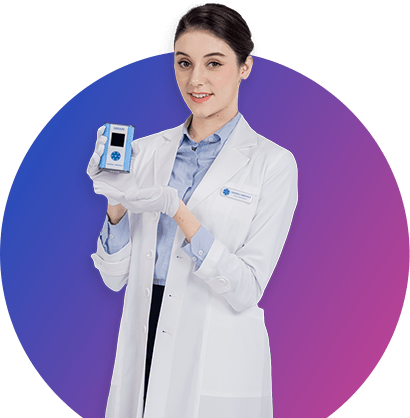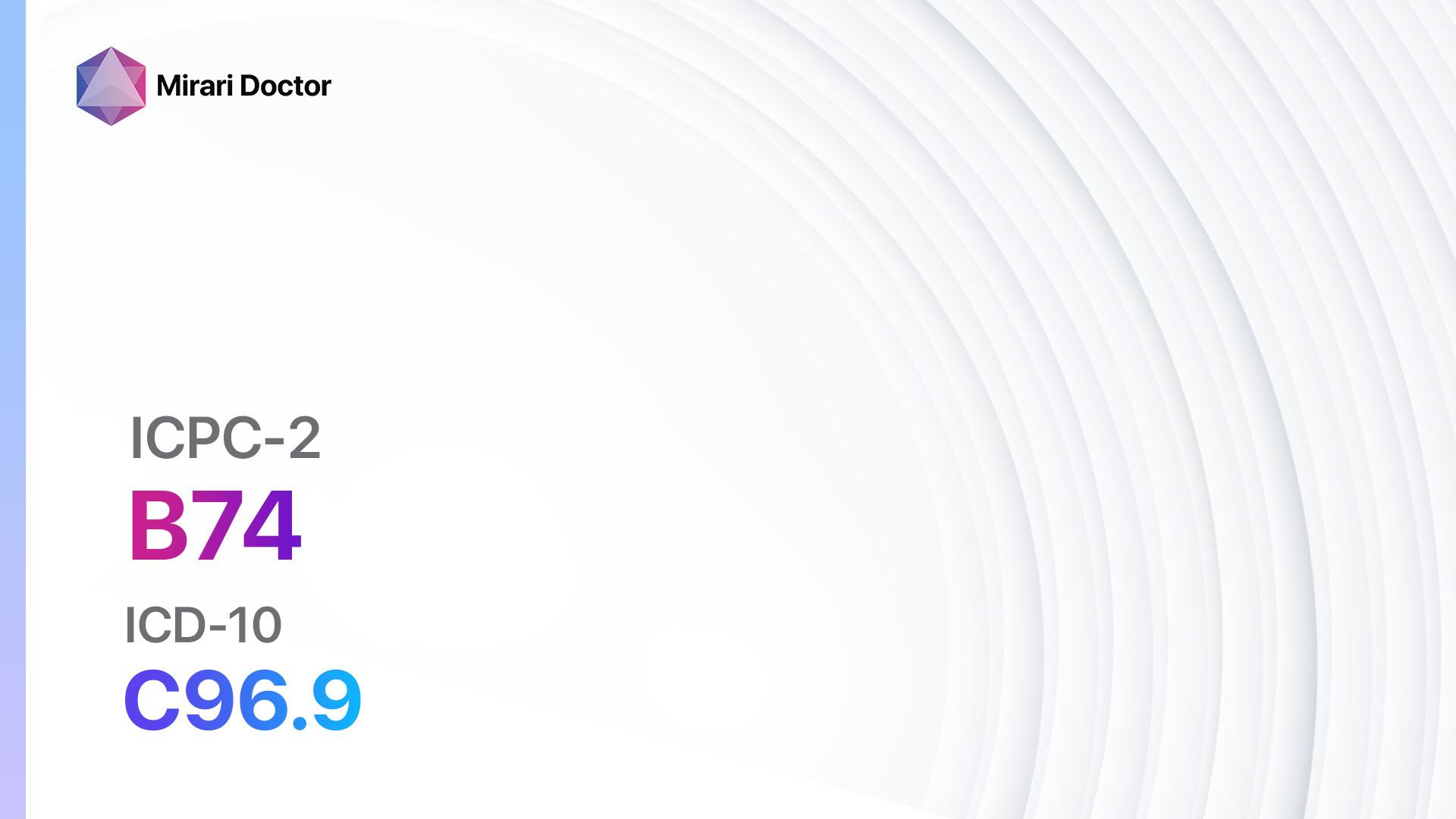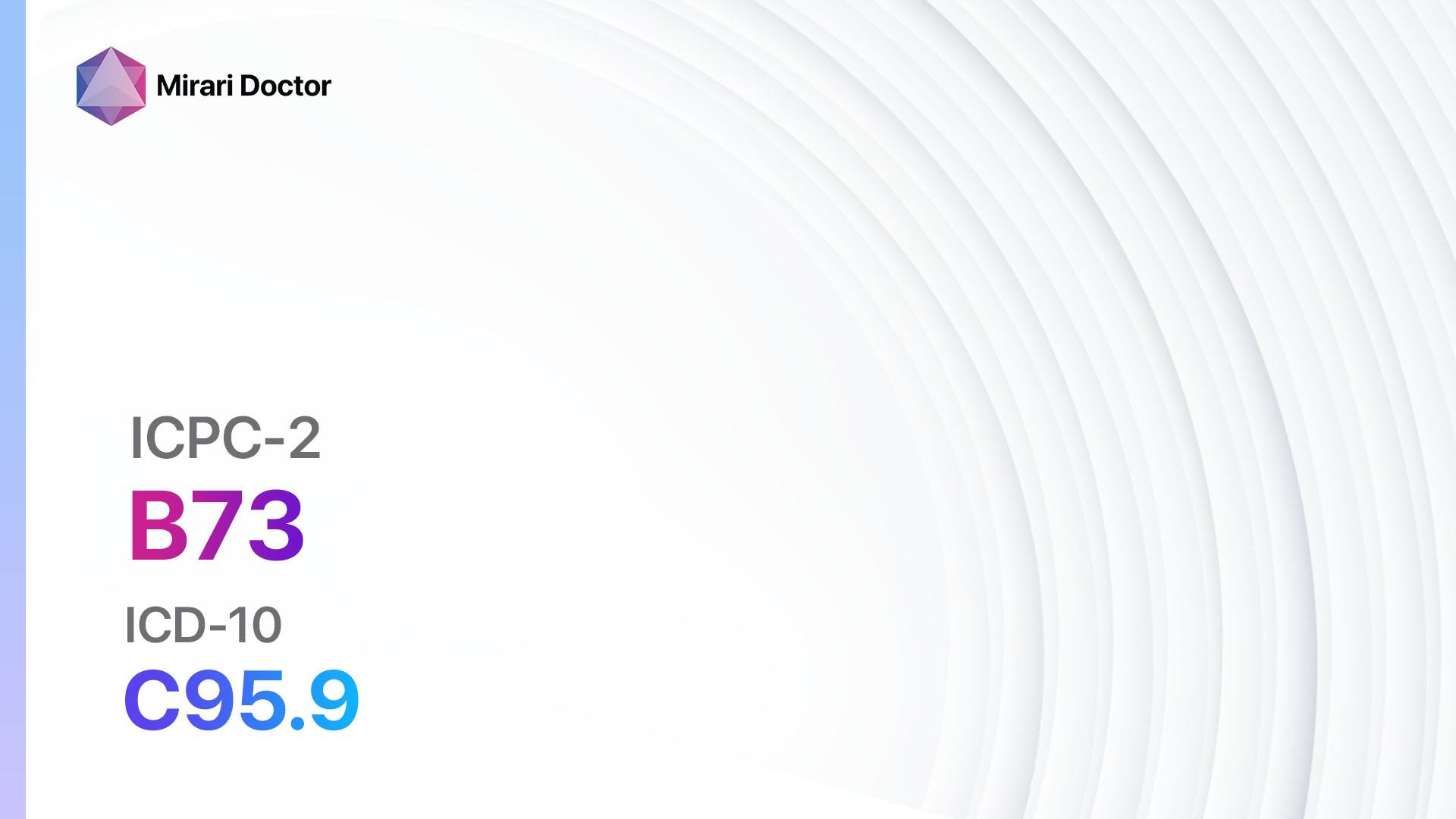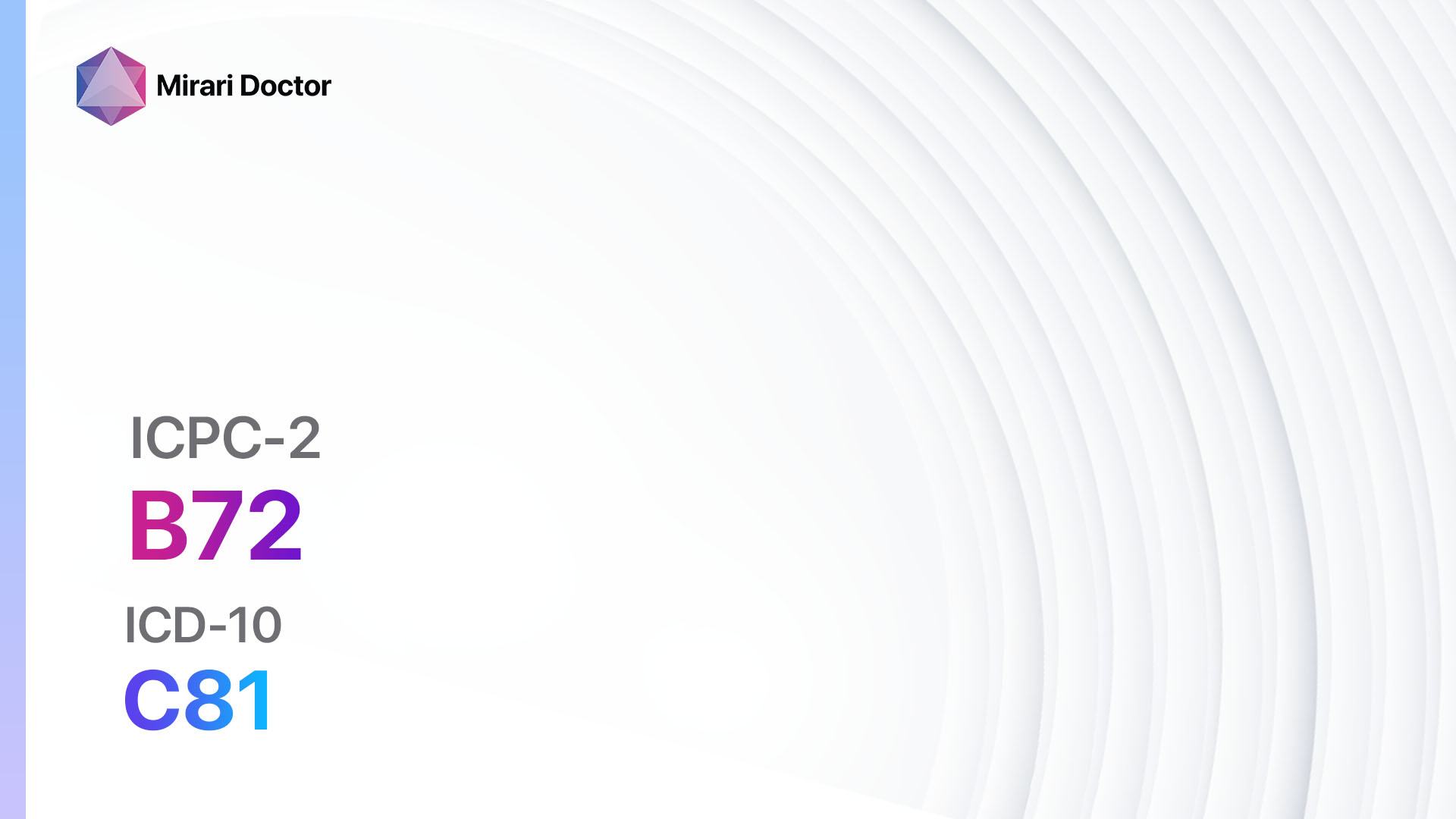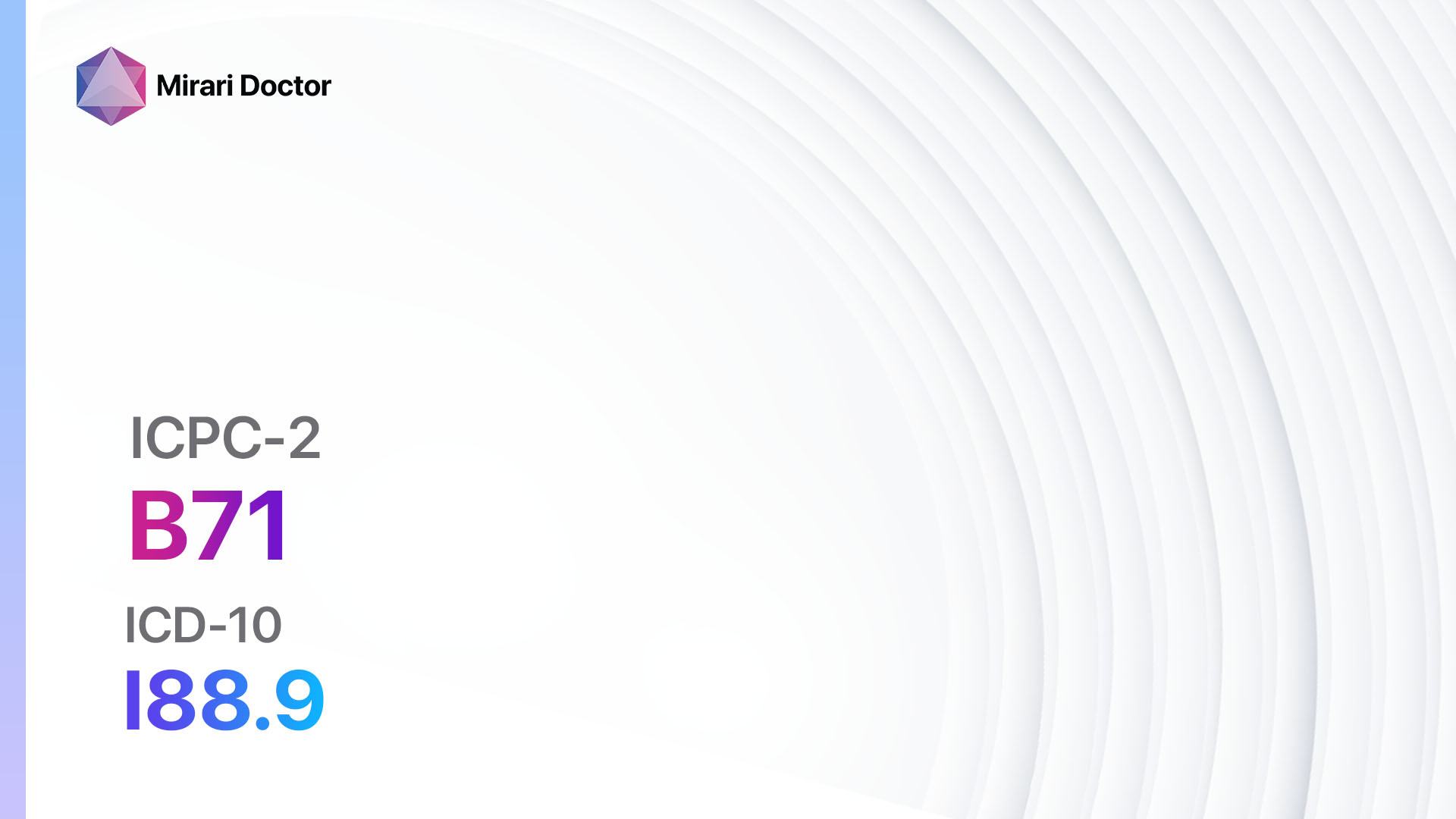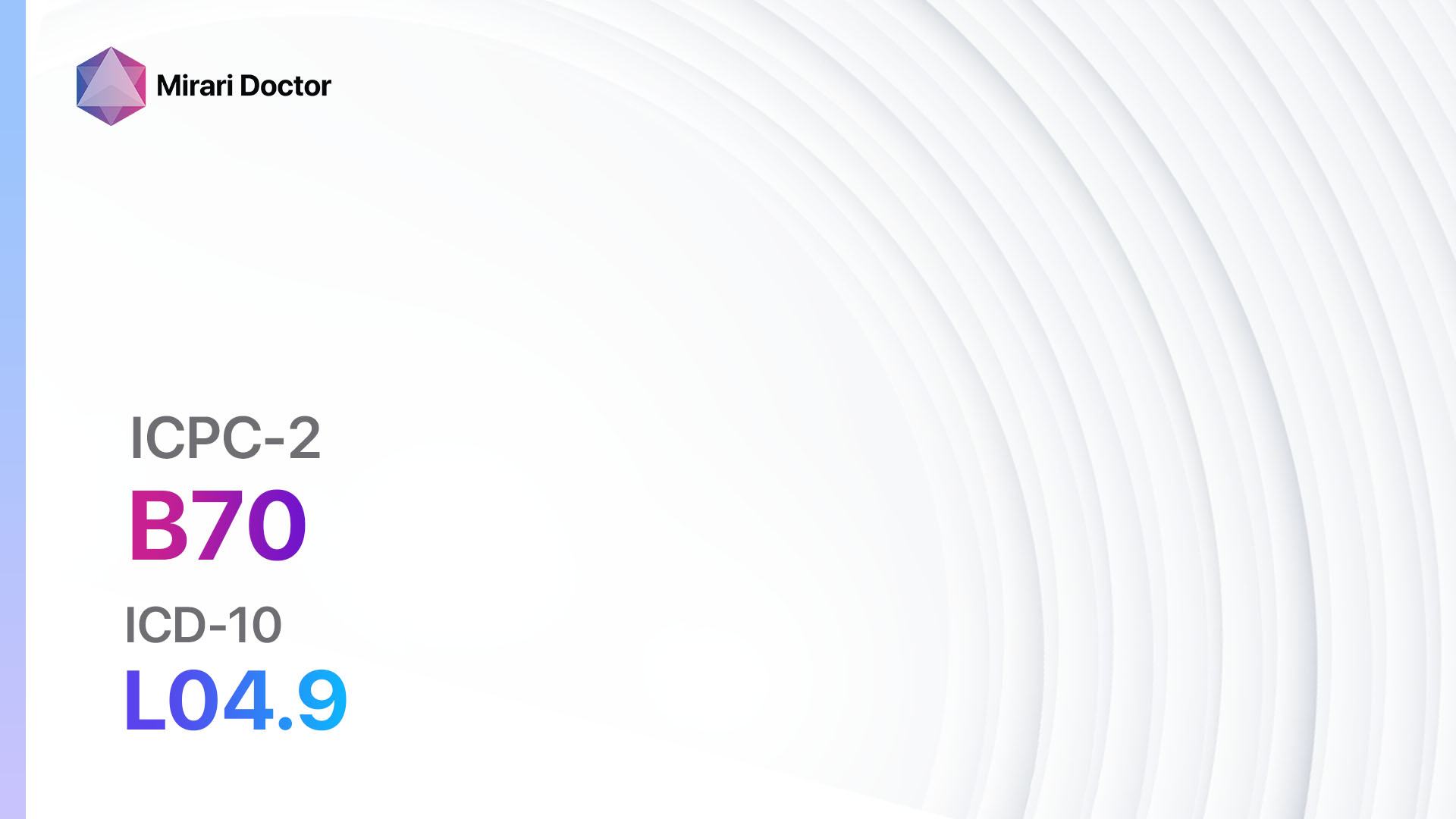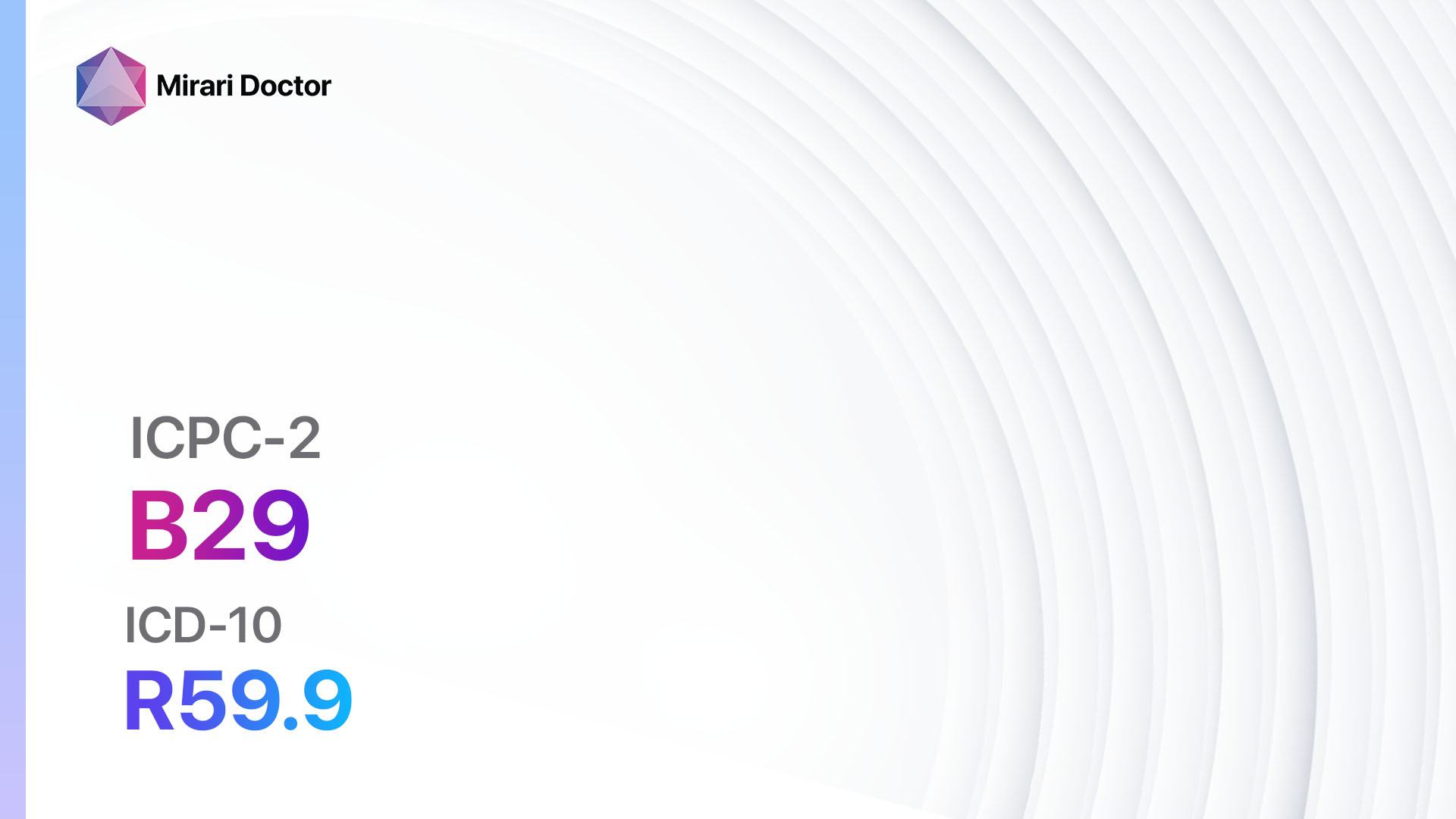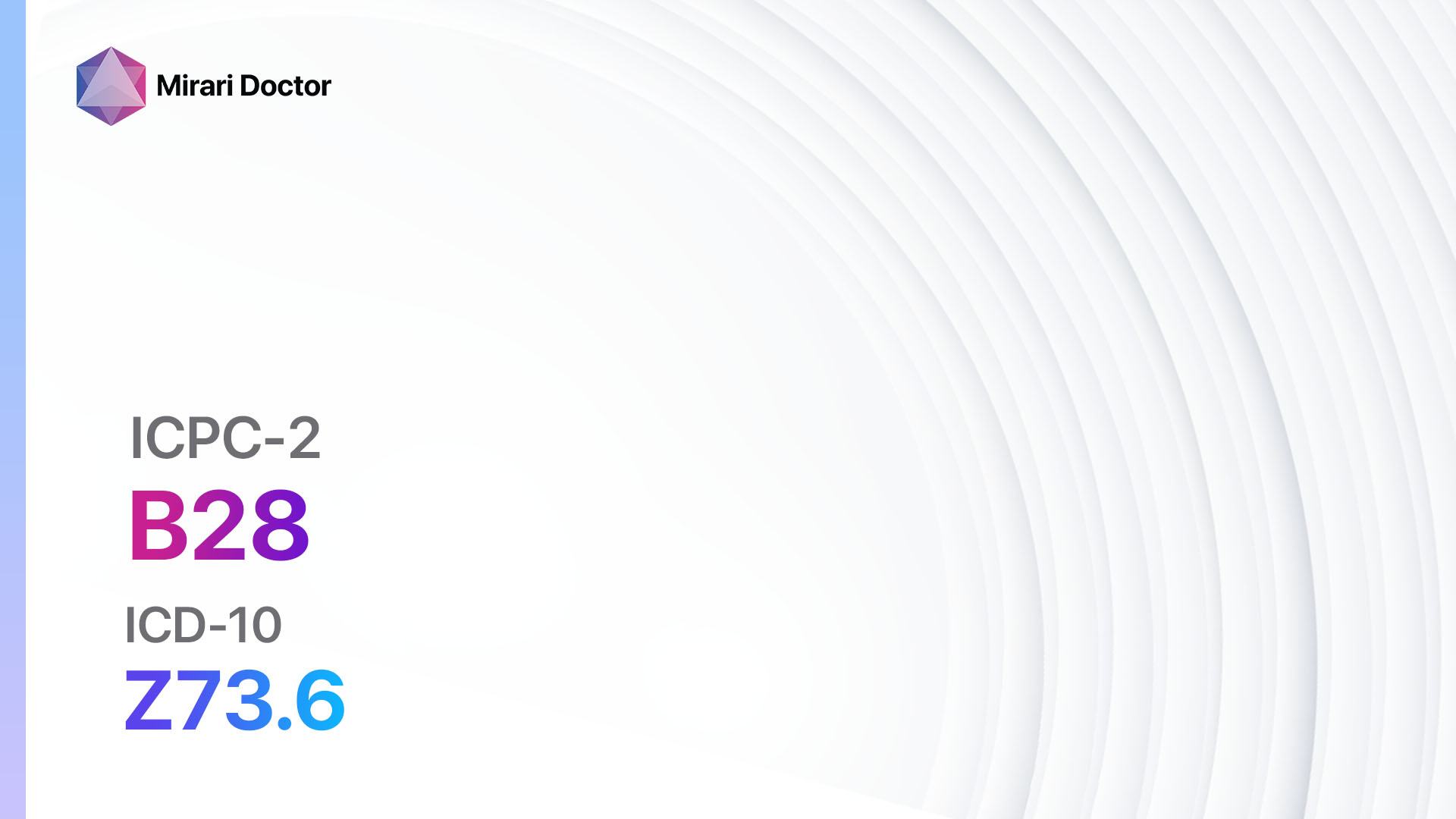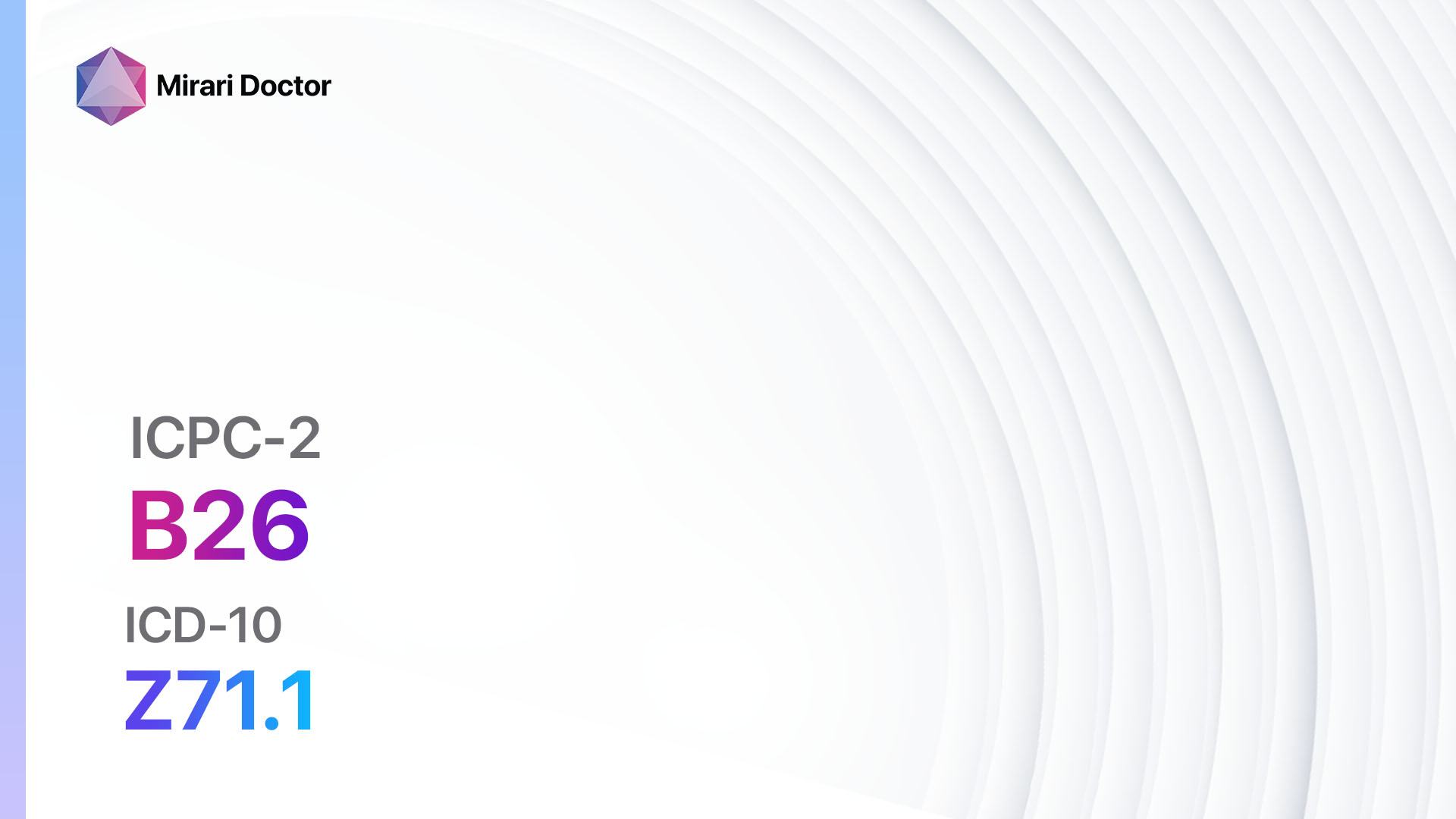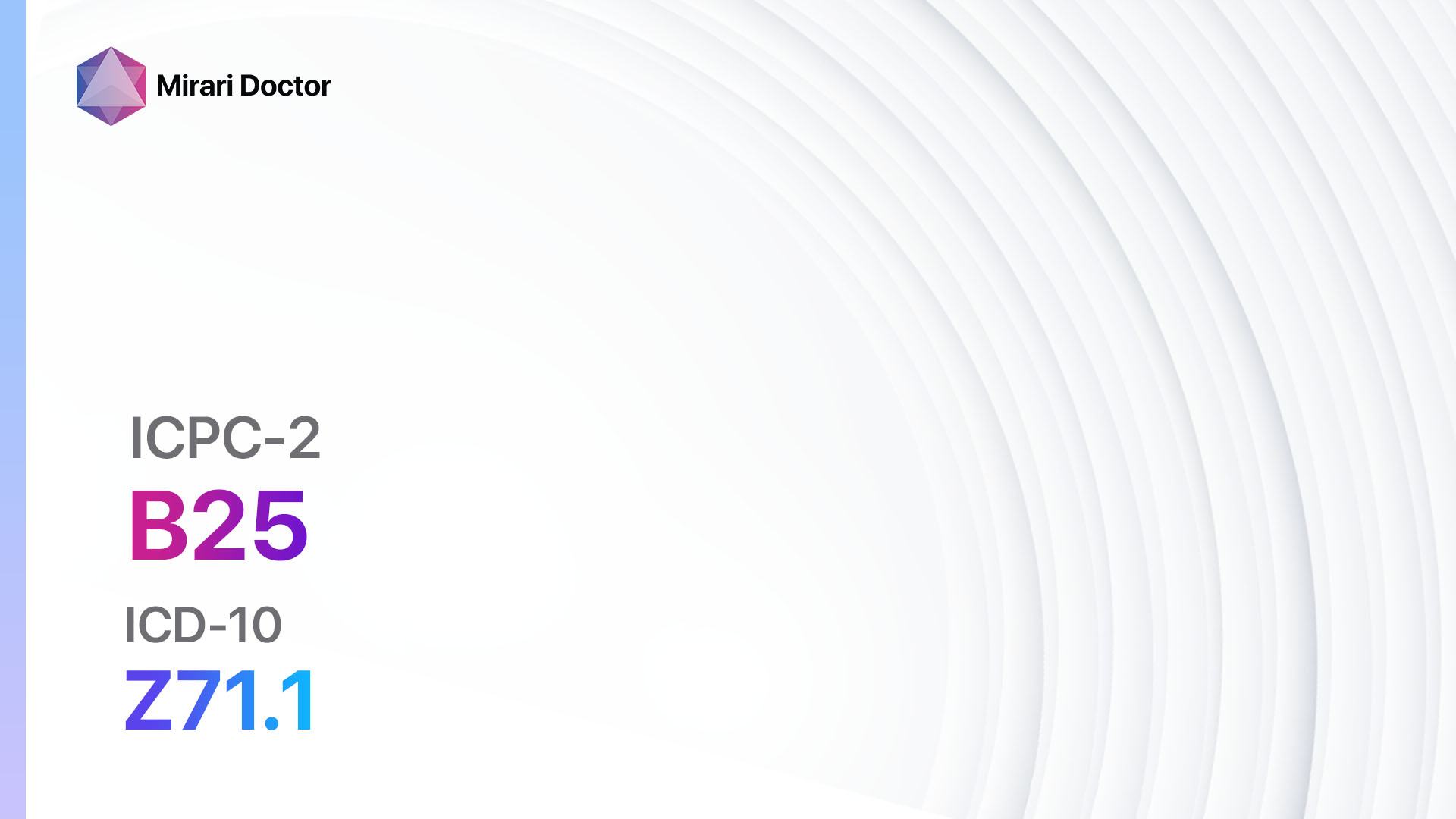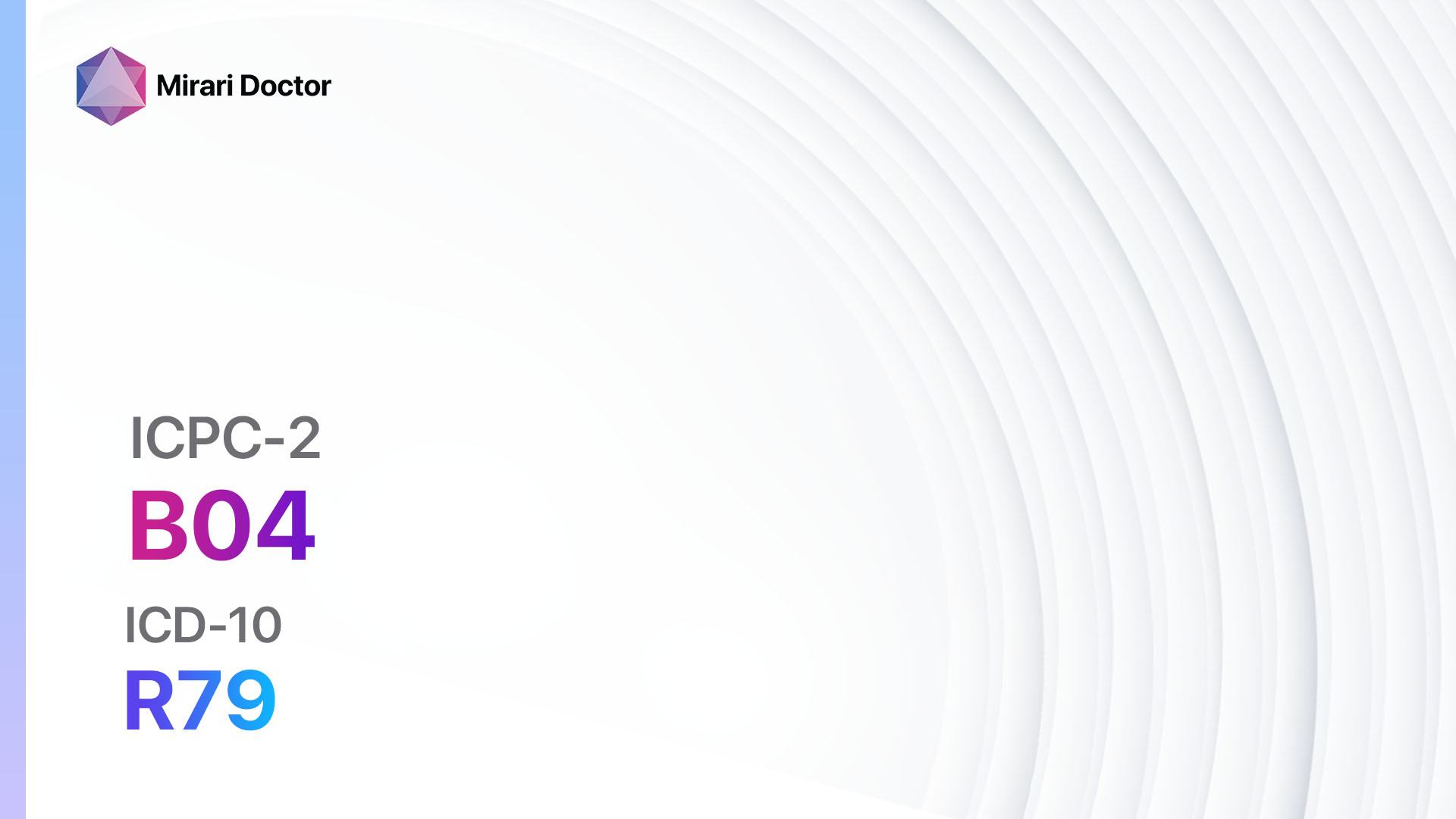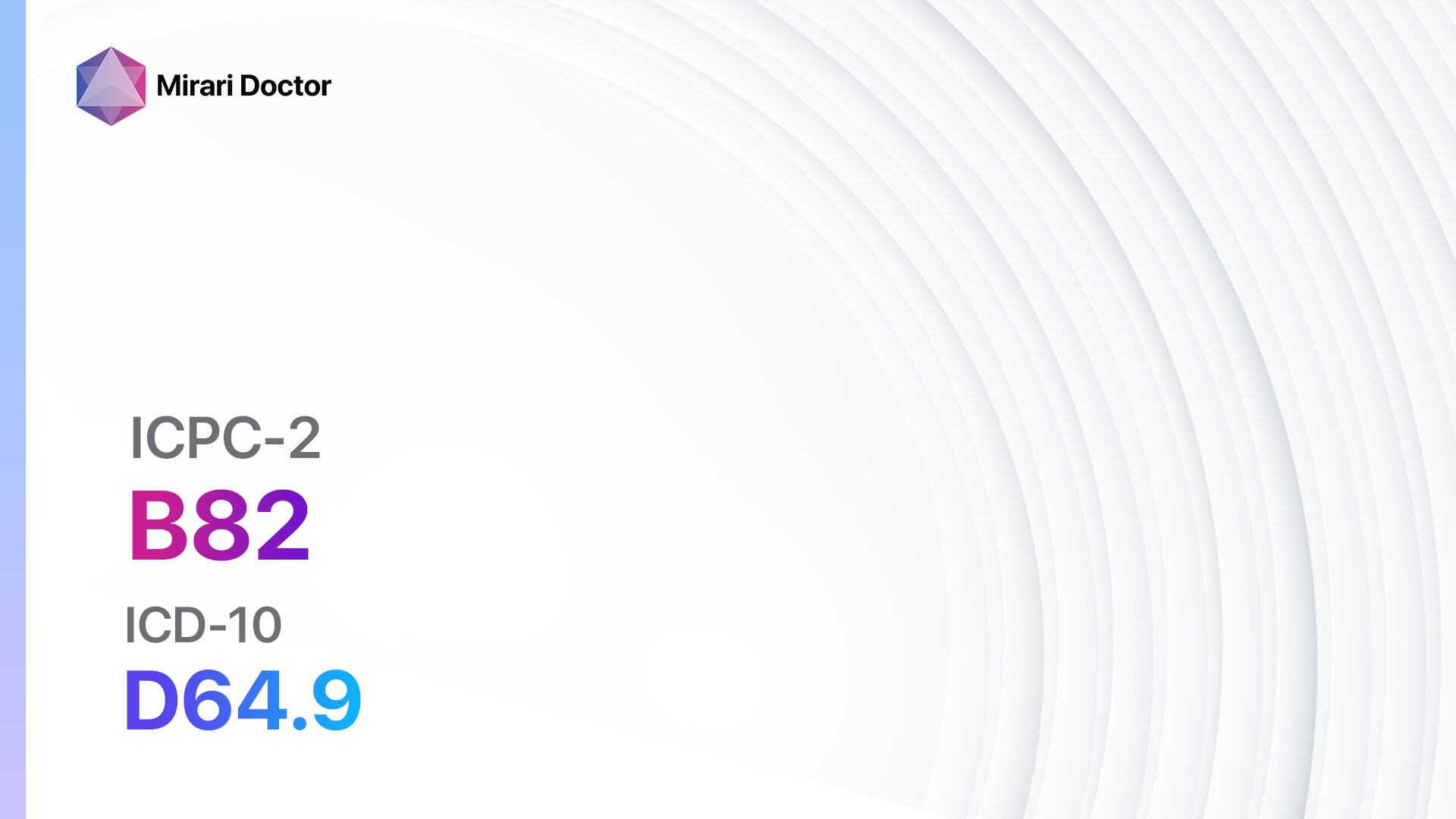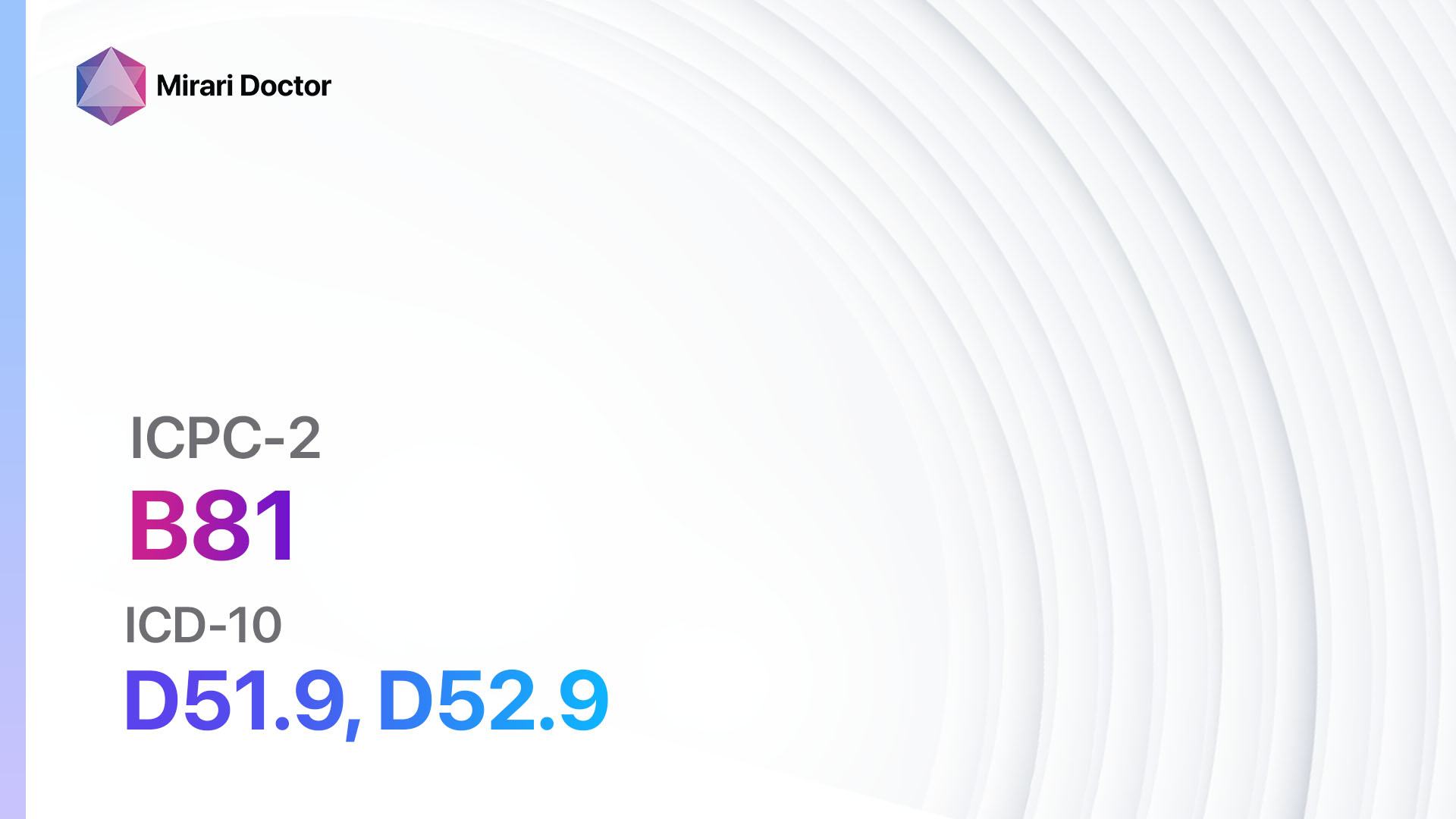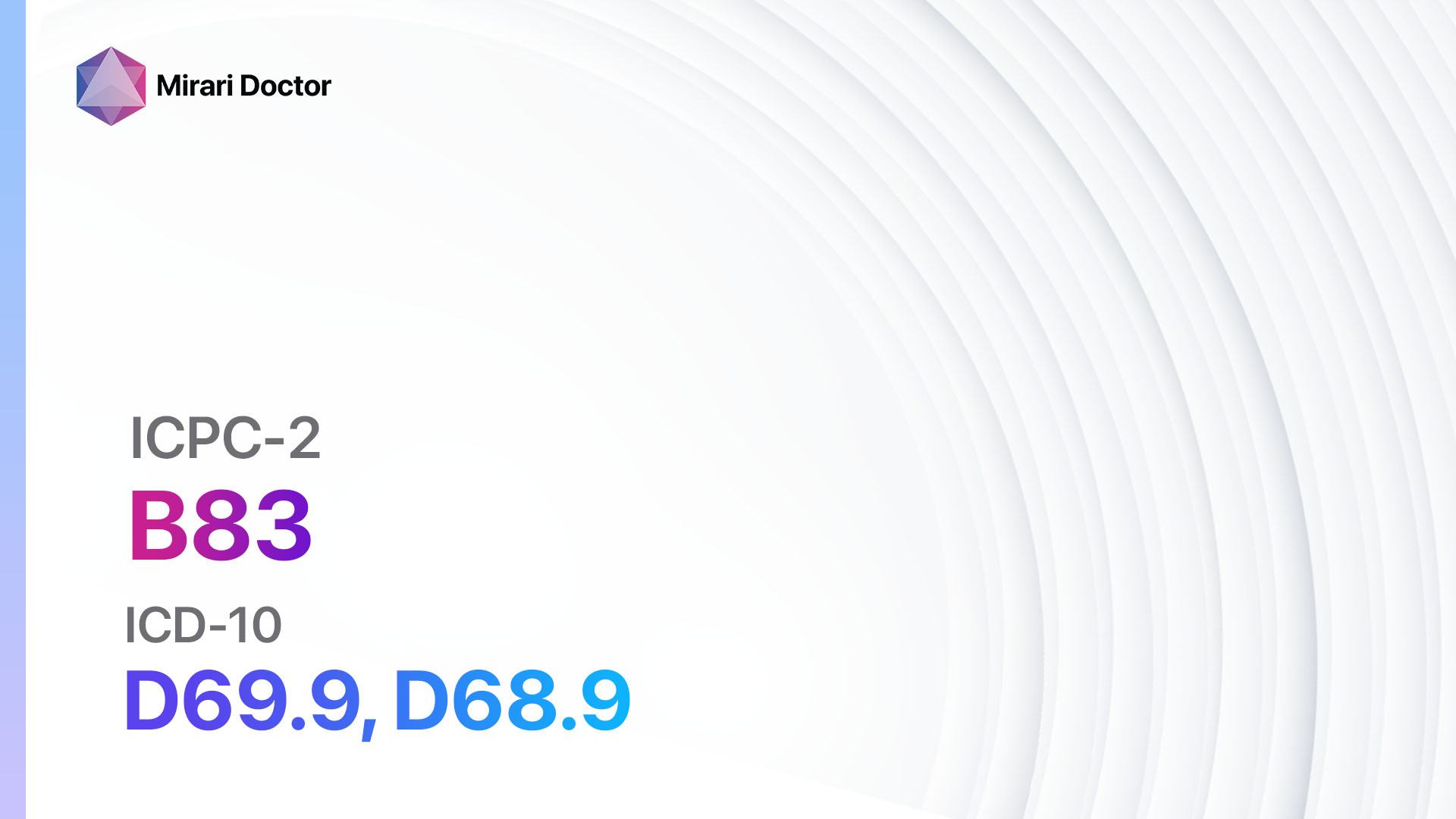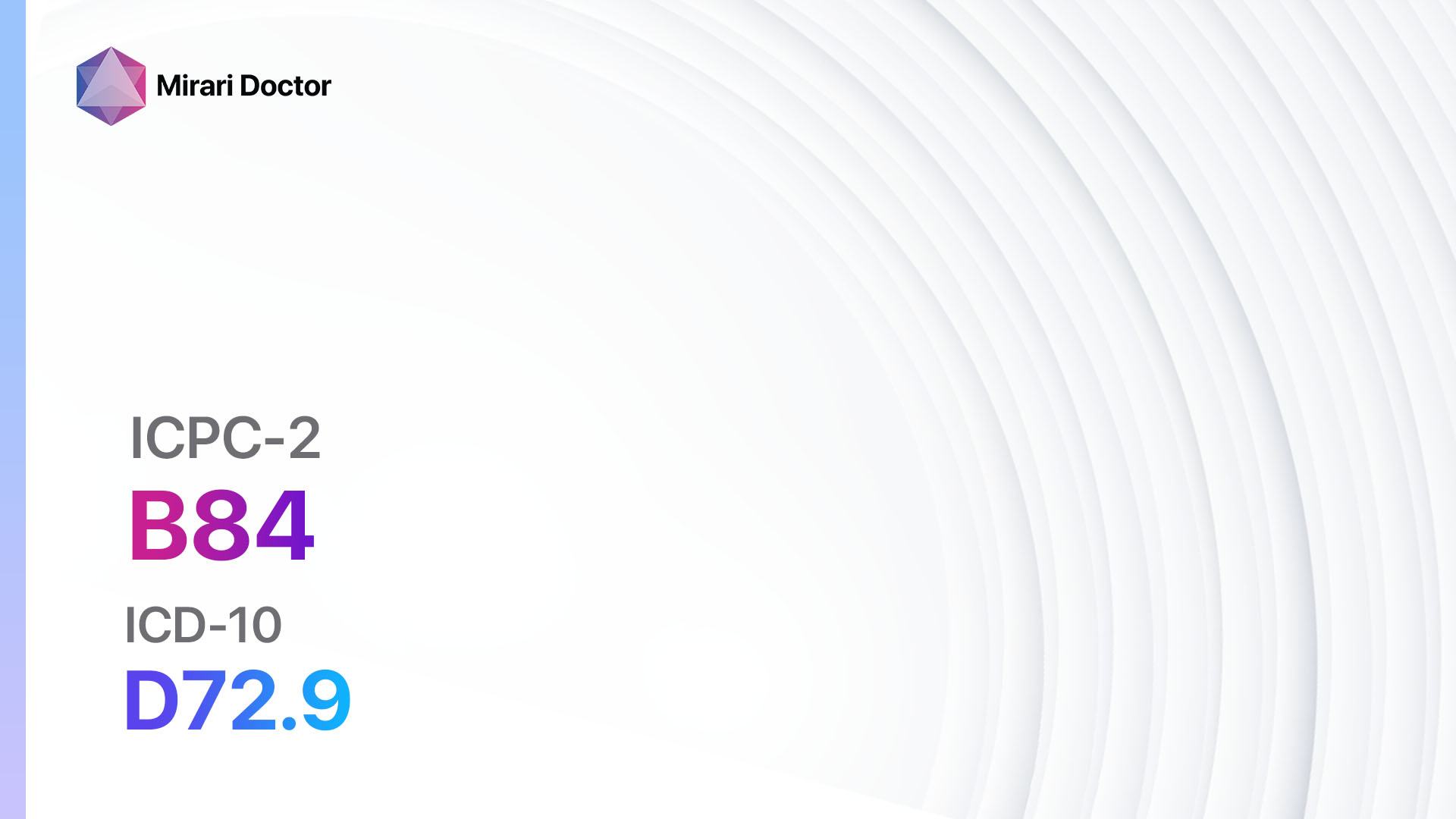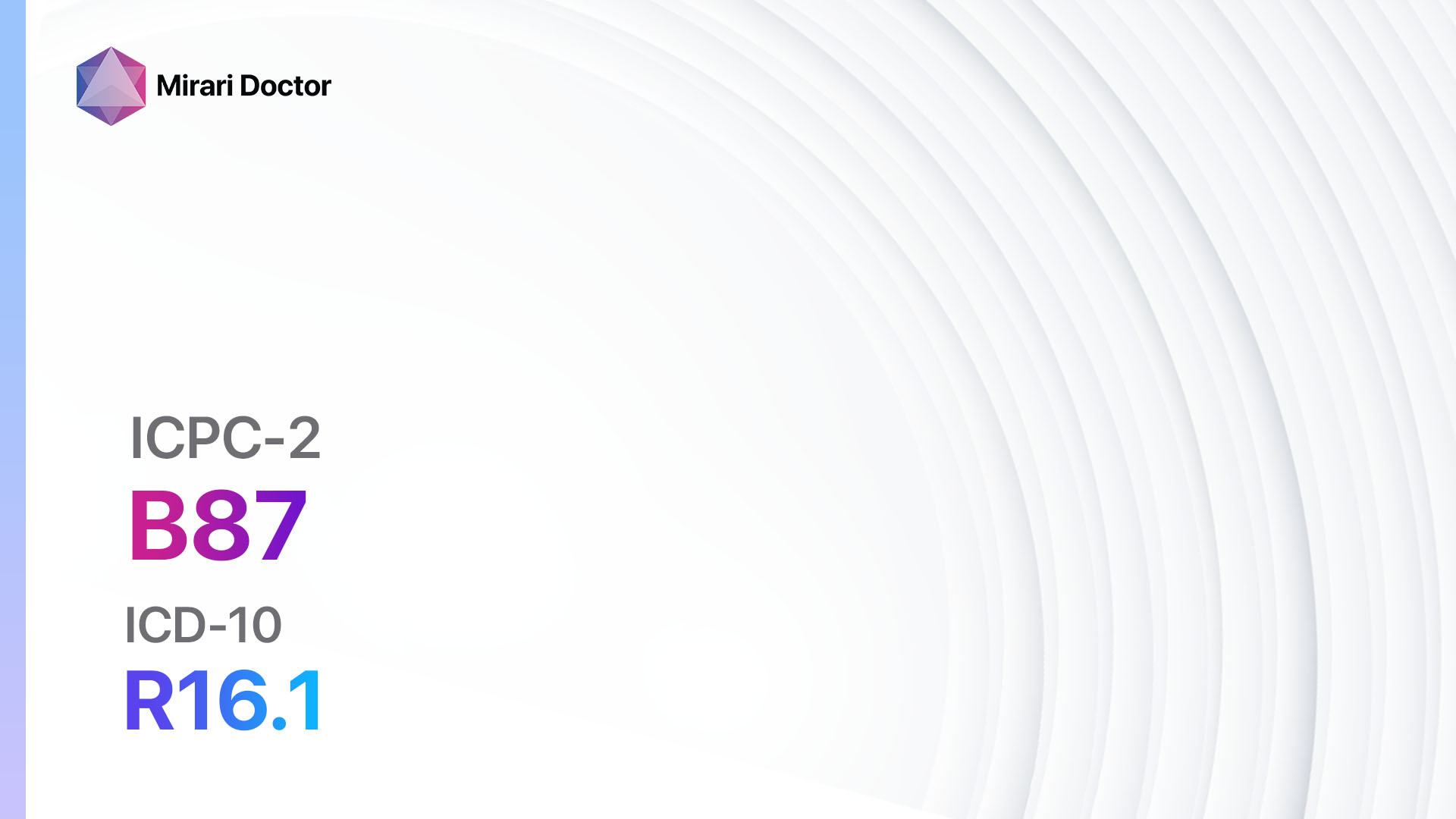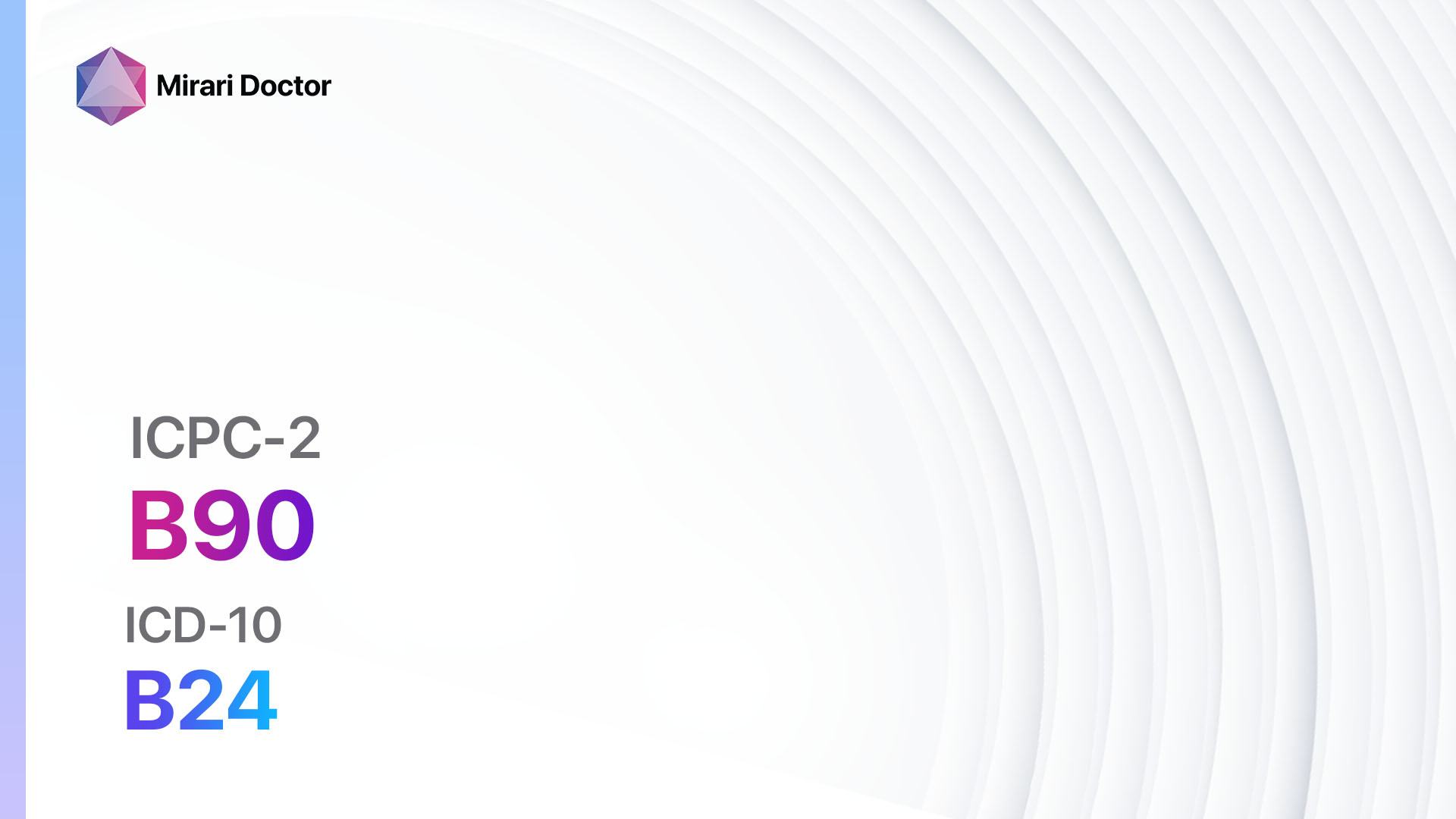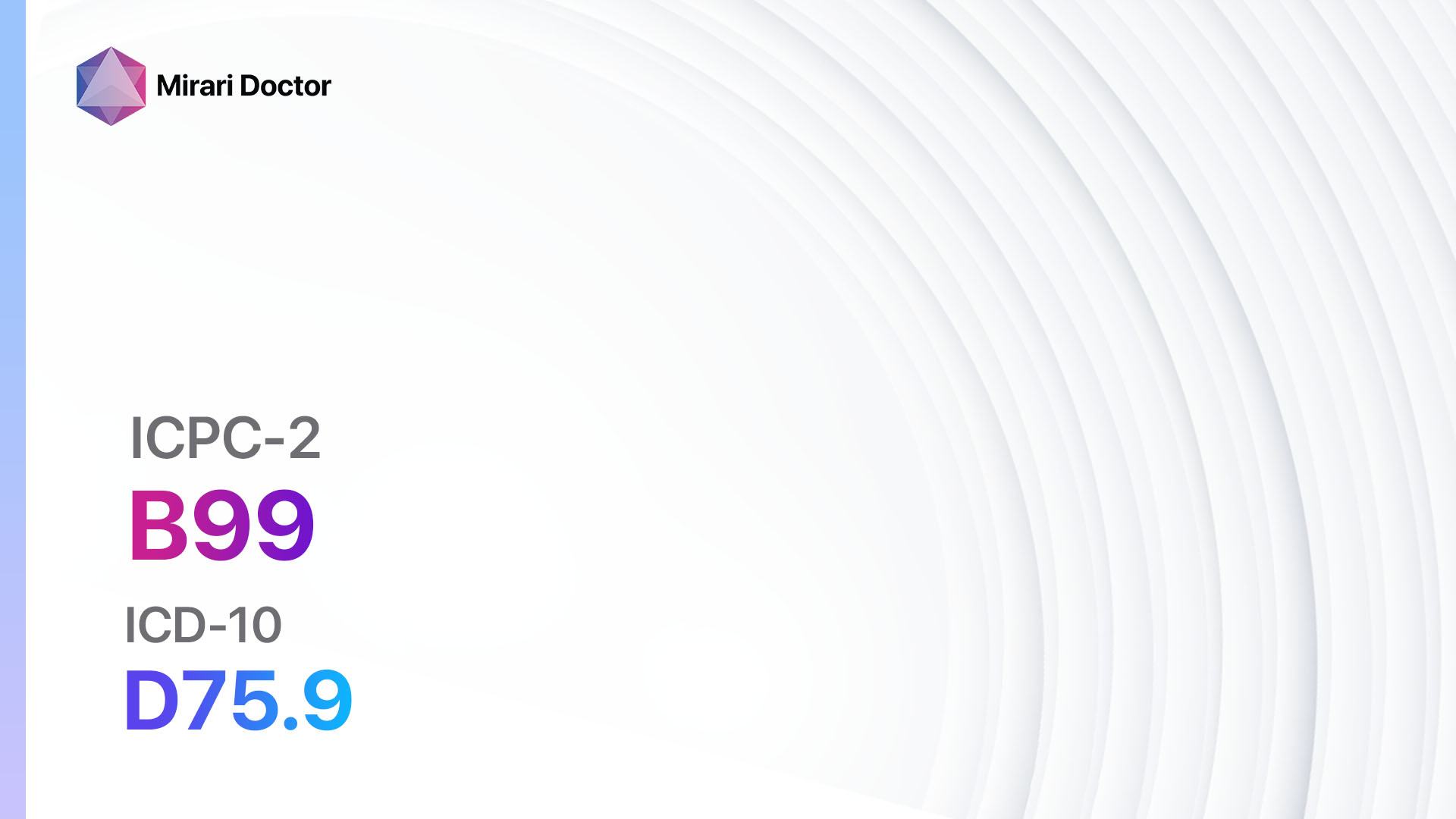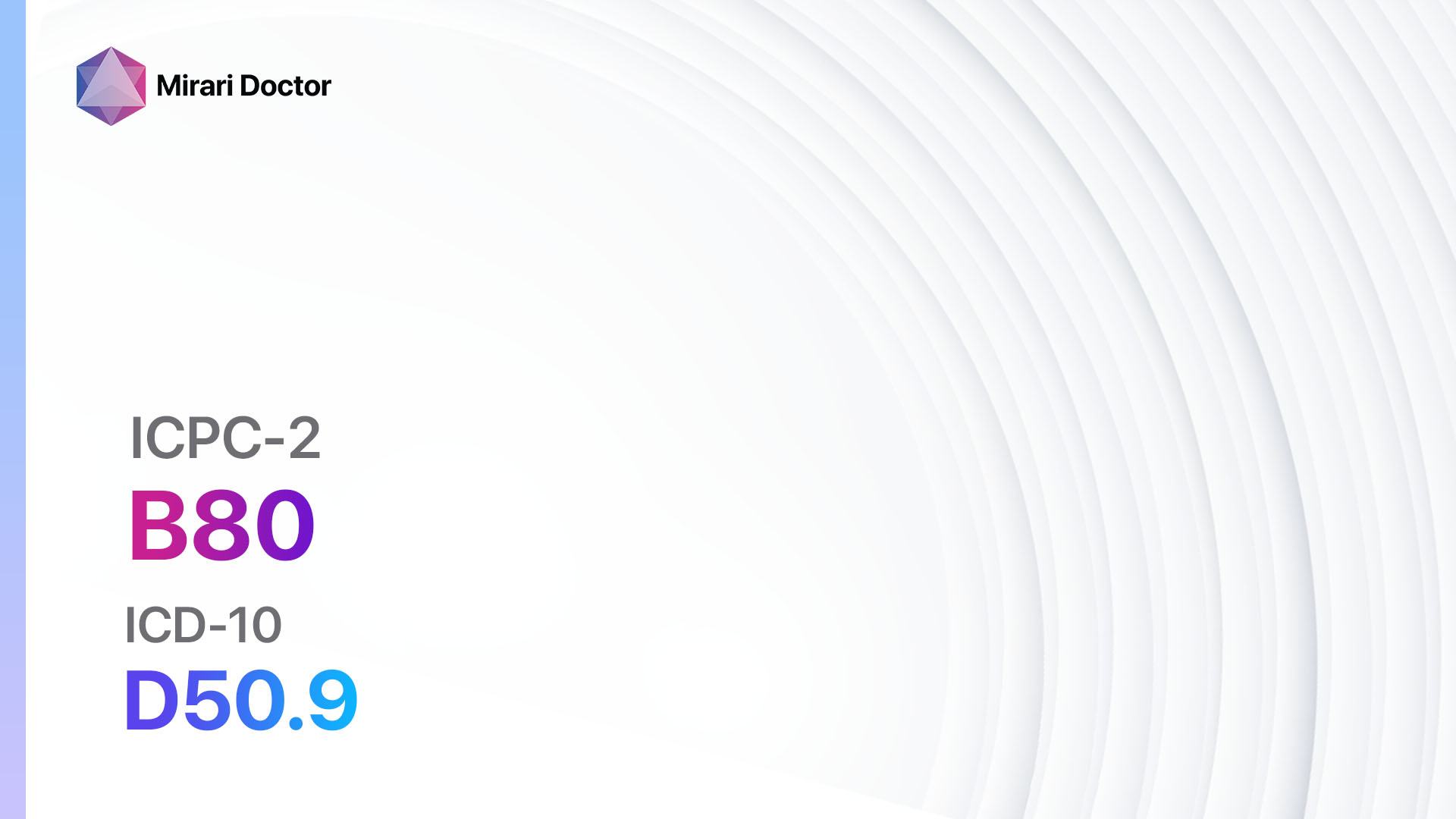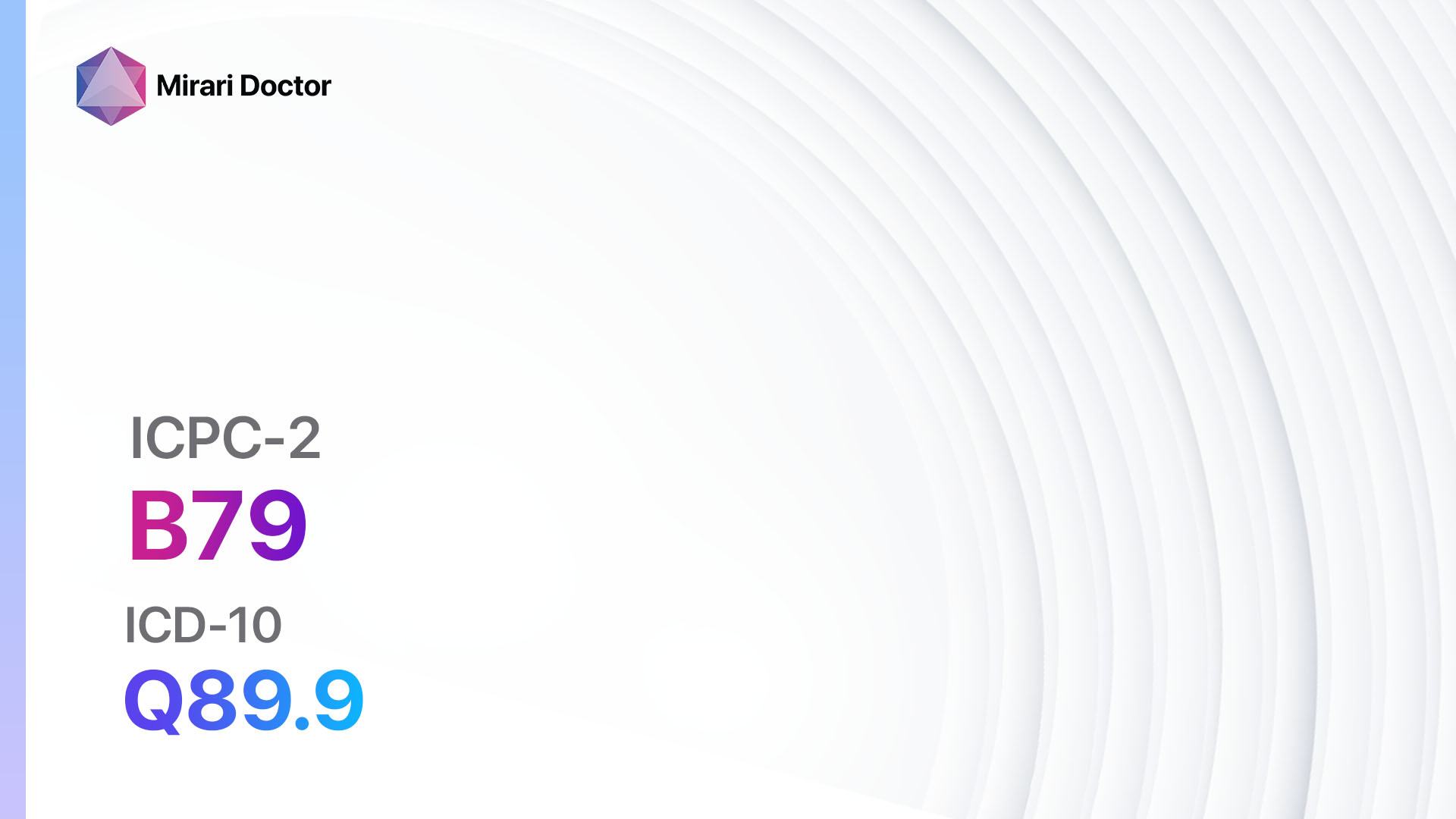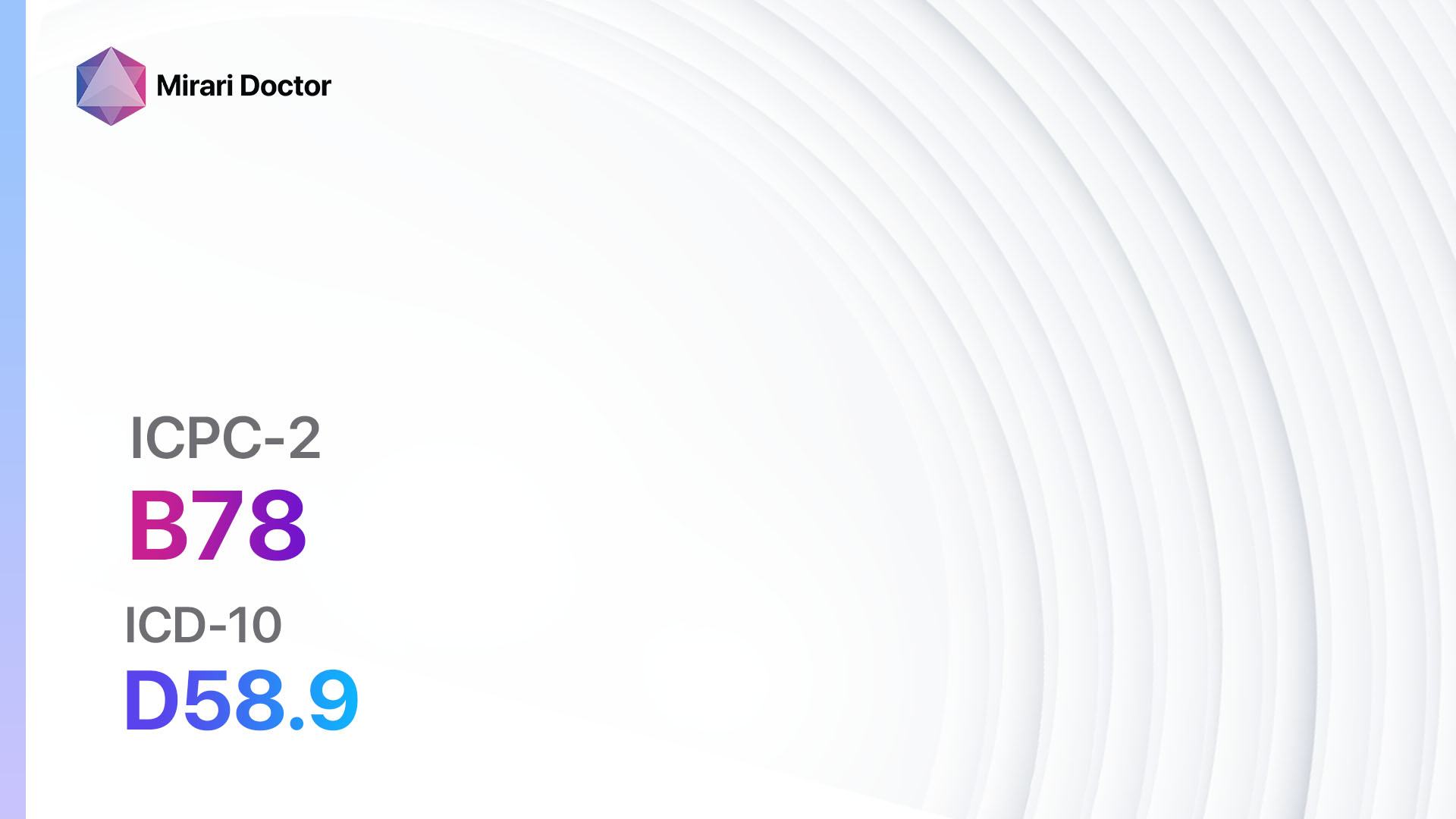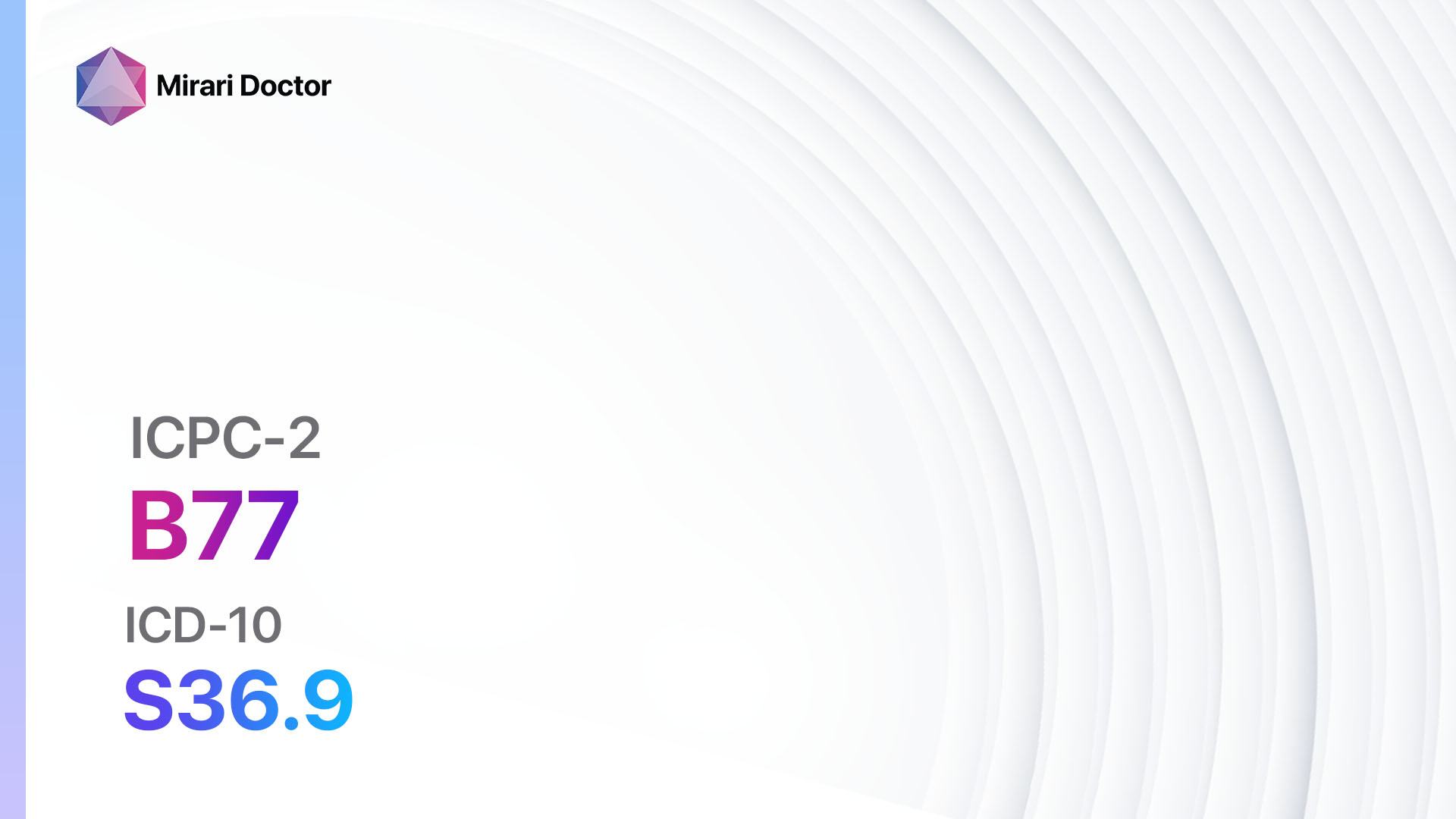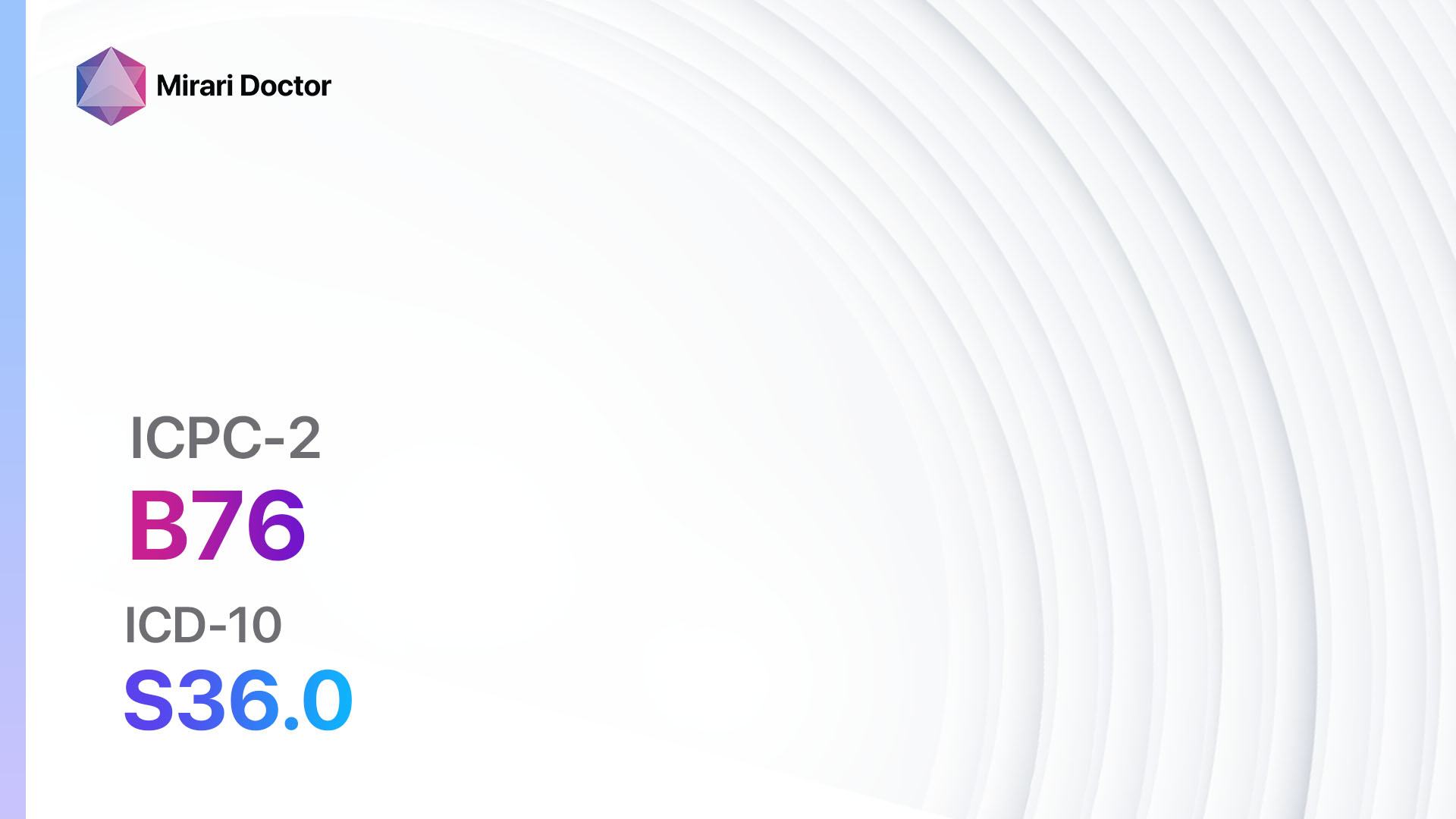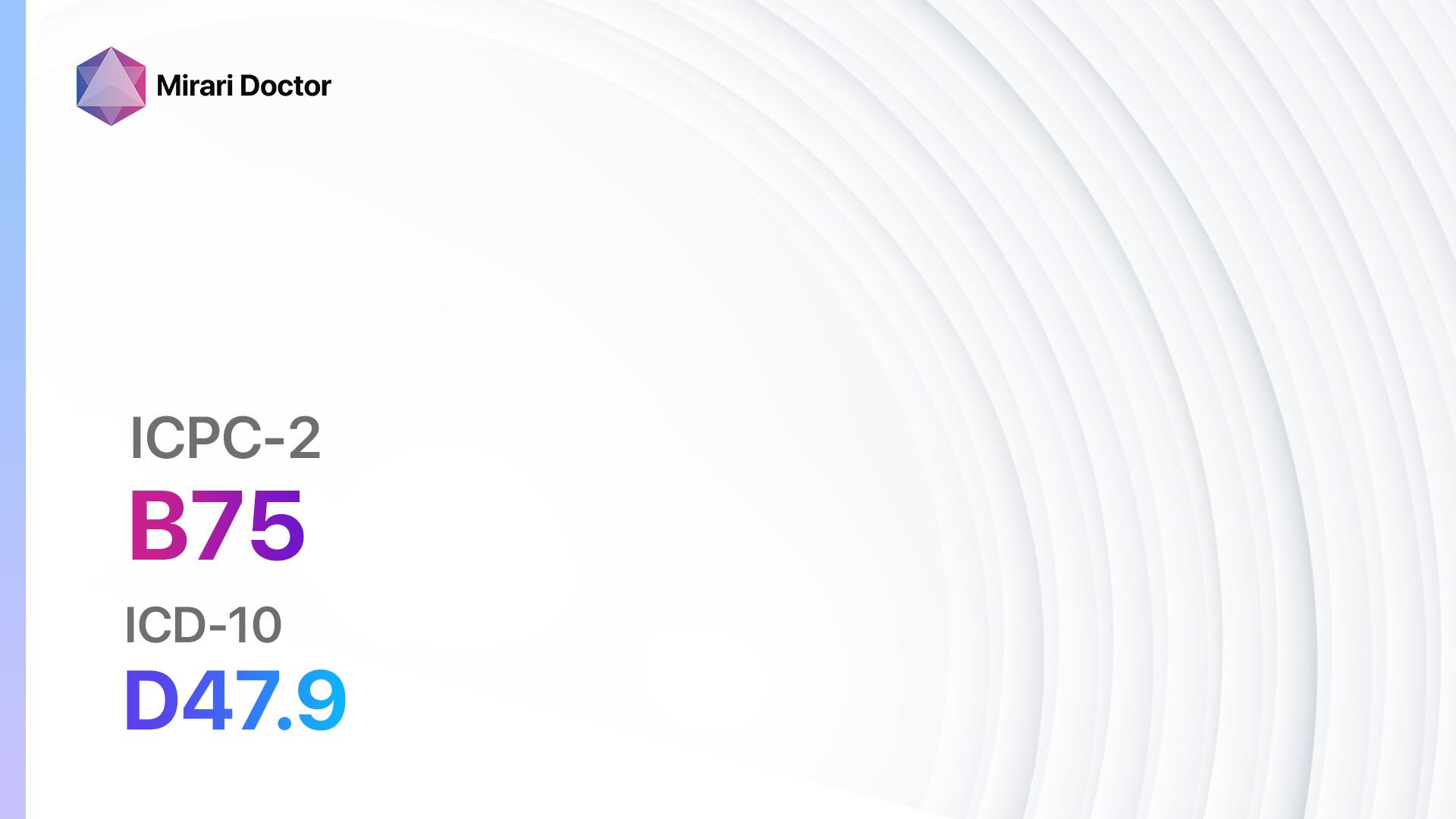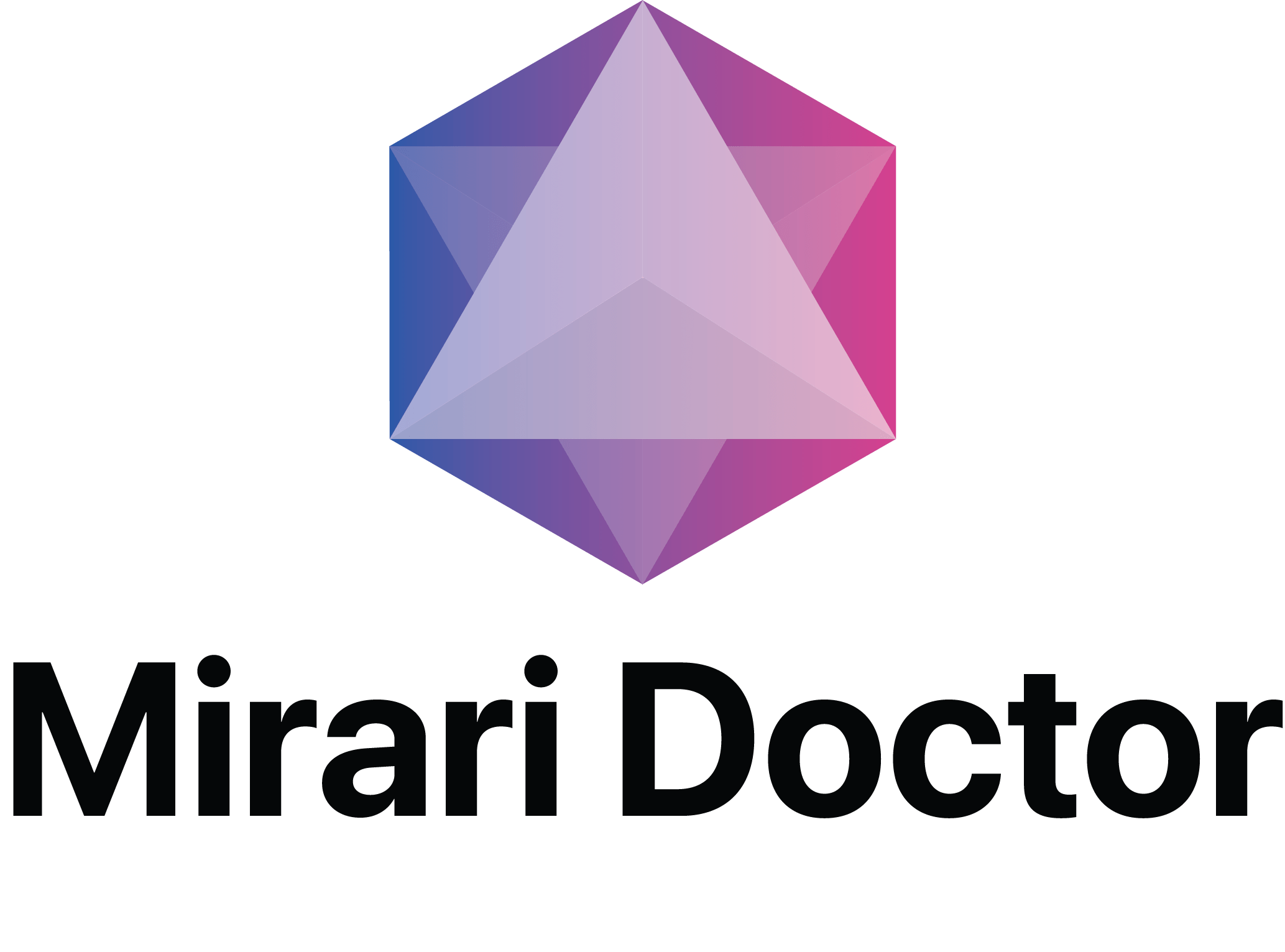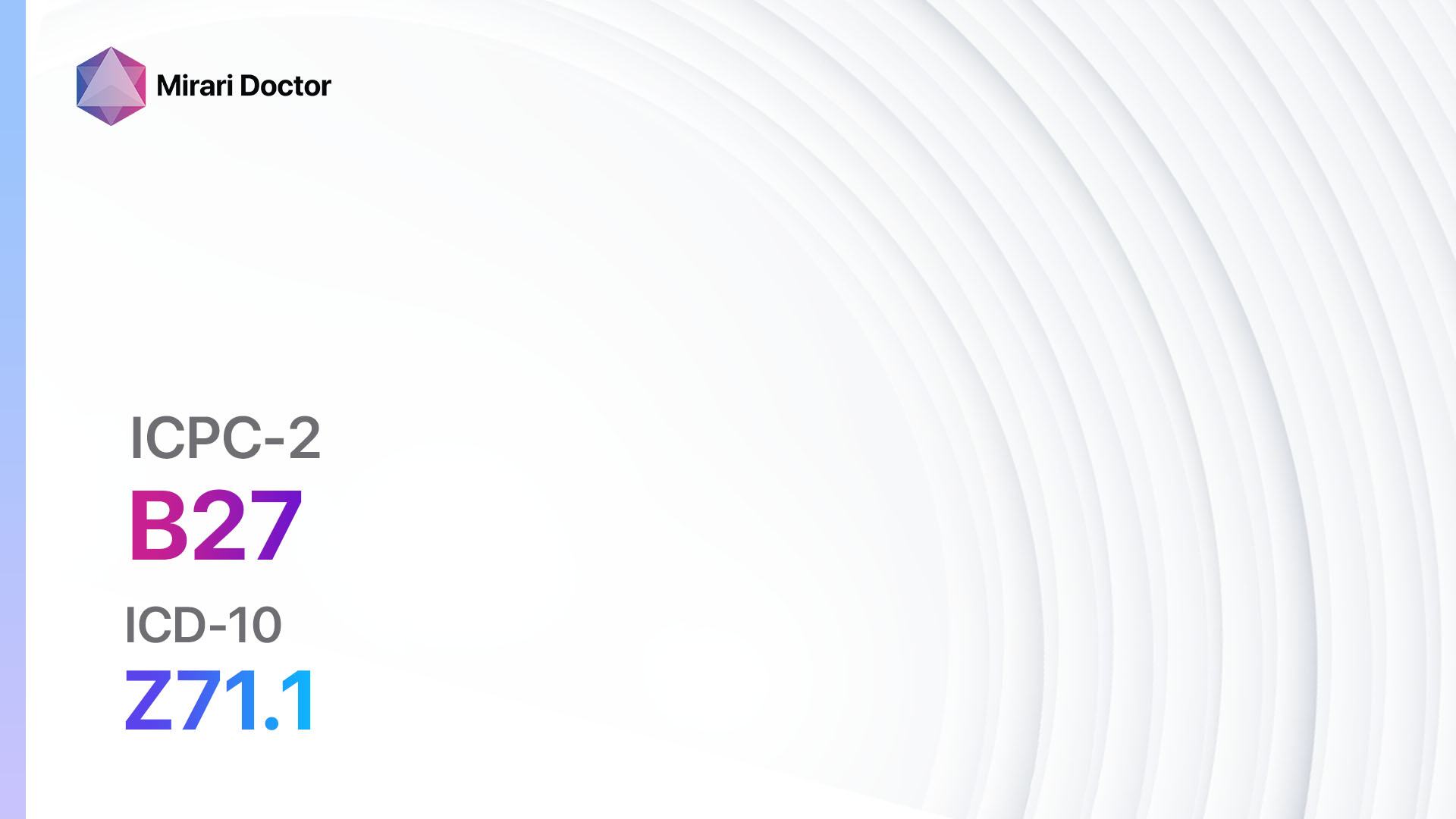
Introduction
Fear of blood/lymph disease other (ICPC-2: B27) is a specific type of health anxiety characterized by excessive and irrational fear or concern about developing diseases of the blood or lymphatic system[1]. This condition falls under the broader category of illness anxiety disorder or health anxiety, where individuals experience persistent worry about having or developing serious medical conditions despite lack of clinical evidence[2]. The fear may be triggered by awareness of symptoms, medical information, or exposure to blood/lymphatic-related medical procedures[3]. While some level of health awareness is normal and adaptive, this condition involves disproportionate anxiety that significantly impairs daily functioning and quality of life[4]. Understanding this condition is essential for healthcare providers to differentiate between appropriate health vigilance and pathological health anxiety, and to provide effective treatment strategies[5].
Codes
- ICPC-2 Code: B27 Fear blood/lymph disease other
- ICD-10 Code: Z71.1 Person with feared complaint in whom no diagnosis is made[6]
Symptoms
The symptoms of fear of blood/lymph disease other encompass psychological, behavioral, and physical manifestations[7]:
Psychological Symptoms
- Excessive fear or anxiety: Persistent, irrational worry about developing blood or lymphatic diseases that is disproportionate to actual risk[8]
- Catastrophic thinking: Tendency to interpret benign physical sensations as signs of serious blood or lymphatic disorders[9]
- Preoccupation with symptoms: Obsessive focus on normal bodily functions or minor symptoms, interpreting them as evidence of disease[10]
- Intrusive thoughts: Unwanted, repetitive thoughts about having blood or lymphatic diseases[11]
- Health-related rumination: Persistent mental reviewing of symptoms, medical information, or disease possibilities[12]
Behavioral Symptoms
- Avoidance behaviors: Avoiding medical procedures, blood tests, hospitals, or discussions about blood/lymphatic diseases[13]
- Excessive health-seeking: Frequent medical consultations, multiple opinions, or repeated testing for reassurance[14]
- Body checking: Compulsive self-examination for symptoms such as lymph node palpation or skin inspection[15]
- Information seeking: Excessive internet research about blood/lymphatic diseases or symptom checking[16]
- Reassurance seeking: Repeatedly asking family, friends, or healthcare providers for confirmation about health status[17]
Physical Symptoms (Anxiety-Related)
- Cardiovascular symptoms: Rapid heartbeat, palpitations, chest pain, or elevated blood pressure during anxiety episodes[18]
- Respiratory symptoms: Shortness of breath, hyperventilation, or feeling of suffocation[19]
- Neurological symptoms: Dizziness, lightheadedness, trembling, or muscle tension[20]
- Gastrointestinal symptoms: Nausea, stomach upset, or changes in appetite related to anxiety[21]
- Sleep disturbances: Insomnia, frequent awakening, or nightmares related to health fears[22]
Social and Occupational Impact
- Functional impairment: Difficulty performing work, social, or family responsibilities due to health anxiety[23]
- Social withdrawal: Avoiding social situations that might trigger health-related discussions or fears[24]
- Relationship strain: Impact on relationships due to excessive need for reassurance or avoidance behaviors[25]
Panic Attacks
Some individuals may experience panic attacks when exposed to blood/lymph-related stimuli, characterized by[26]:
- Intense fear or terror
- Physical symptoms reaching peak intensity within minutes
- Fear of losing control or dying
- Feelings of unreality or detachment
Causes
The development of fear of blood/lymph disease other involves multiple interacting factors[27]:
Psychological Factors
- Anxiety sensitivity: Heightened fear of anxiety-related sensations and their consequences[28]
- Intolerance of uncertainty: Difficulty accepting ambiguous or uncertain health information[29]
- Catastrophic misinterpretation: Tendency to interpret normal bodily sensations as signs of serious illness[30]
- Perfectionism: Need for complete certainty about health status[31]
Traumatic or Triggering Experiences
- Medical trauma: Previous negative experiences with medical procedures, hospitalization, or diagnosis[32]
- Vicarious trauma: Witnessing illness or death in family members or friends, particularly from blood or lymphatic diseases[33]
- Media exposure: Exposure to frightening medical information through news, documentaries, or social media[34]
- False alarms: Previous episodes where symptoms were feared to indicate serious illness but were later found to be benign[35]
Biological and Genetic Factors
- Genetic predisposition: Family history of anxiety disorders increases risk of developing health anxiety[36]
- Neurobiological factors: Overactivity in brain regions responsible for threat detection, such as the amygdala[37]
- Stress response system: Dysregulation of the hypothalamic-pituitary-adrenal (HPA) axis affecting stress and anxiety responses[38]
Cognitive Factors
- Attention bias: Selective attention to health-related information and bodily sensations[39]
- Memory bias: Enhanced recall for health-threatening information[40]
- Interpretation bias: Tendency to interpret ambiguous health information in a threatening manner[41]
Environmental and Social Factors
- Family modeling: Learning anxious health behaviors from family members[42]
- Cultural factors: Societal attitudes toward illness and healthcare that promote health anxiety[43]
- Healthcare experiences: Previous encounters with healthcare that reinforced health anxiety[44]
- Information overload: Easy access to medical information online leading to misinterpretation[45]
Comorbid Conditions
- Other anxiety disorders: Generalized anxiety disorder, panic disorder, or specific phobias[46]
- Mood disorders: Depression or bipolar disorder[47]
- Obsessive-compulsive disorder: Particularly with contamination or health-related obsessions[48]
Diagnostic Steps
Medical History
Comprehensive evaluation should include[49]:
Anxiety and Fear Assessment
- Fear characteristics: Onset, duration, intensity, and specific triggers of blood/lymph disease fears
- Functional impact: How fears affect work, relationships, and daily activities
- Temporal patterns: Relationship between fears and life events, stressors, or medical experiences
- Associated symptoms: Presence of panic attacks, avoidance behaviors, or compulsions
Medical and Healthcare History
- Previous medical experiences: Past diagnoses, procedures, hospitalizations, or medical scares
- Family medical history: Blood disorders, cancers, or other serious illnesses in relatives
- Healthcare utilization: Pattern of medical consultations, testing, and treatments sought for reassurance
- Current symptoms: Any actual physical symptoms and their relationship to anxiety
Psychiatric History
- Mental health conditions: Previous or current anxiety disorders, depression, or other psychiatric diagnoses[50]
- Treatment history: Previous psychotherapy, psychiatric medications, or hospitalizations
- Family psychiatric history: Genetic predisposition to anxiety or mood disorders
- Trauma history: Experiences that may have contributed to current health anxiety
Psychosocial Factors
- Social support: Family and friend relationships, social isolation patterns
- Occupational factors: Work-related stressors or exposures that may contribute to fears
- Coping mechanisms: Current strategies used to manage anxiety and their effectiveness
- Substance use: Alcohol or drug use as coping mechanisms
Physical Examination
While the condition is primarily psychological, physical examination serves important functions[51]:
General Assessment
- Vital signs: May reveal elevated heart rate, blood pressure, or respiratory rate due to anxiety
- Overall appearance: Signs of distress, anxiety, or depression
- Nutritional status: Impact of anxiety on eating and self-care
Focused Examination
- Lymphatic system: Examination of lymph nodes to address specific fears and provide reassurance
- Cardiovascular system: Assessment of heart rate, rhythm, and blood pressure
- Neurological examination: Evaluation for anxiety-related symptoms such as tremor or tension
- Skin examination: Assessment for anxiety-related conditions or self-inflicted injuries from checking behaviors
Ruling Out Medical Conditions
- Exclude medical causes: Rule out conditions that could cause similar anxiety symptoms (hyperthyroidism, cardiac arrhythmias)
- Avoid excessive testing: Balance appropriate medical evaluation with avoidance of reinforcing health anxiety through unnecessary tests
Psychological Assessment
Structured Clinical Interviews
- DSM-5-TR criteria: Assessment for anxiety disorders, specific phobias, or illness anxiety disorder[52]
- Severity assessment: Standardized measures such as the Health Anxiety Inventory (HAI) or Whiteley Index[53]
- Functional assessment: Evaluation of impact on daily functioning and quality of life
Cognitive Assessment
- Thought patterns: Identification of catastrophic thinking, cognitive distortions, and health-related beliefs
- Attention and interpretation biases: Assessment of how the patient processes health-related information
- Coping strategies: Evaluation of current coping mechanisms and their effectiveness
Behavioral Assessment
- Avoidance patterns: Documentation of situations, activities, or stimuli that are avoided
- Safety behaviors: Identification of behaviors used to manage anxiety (checking, reassurance-seeking)
- Healthcare utilization patterns: Assessment of frequency and nature of medical consultations
Differential Diagnosis
Medical Conditions
- Hyperthyroidism: Can cause anxiety symptoms that may be misinterpreted as psychological
- Cardiovascular conditions: Arrhythmias or other cardiac conditions causing physical symptoms
- Neurological disorders: Conditions affecting brain function that could cause anxiety
Psychiatric Conditions
- Illness anxiety disorder: Primary focus on having or acquiring a serious illness[54]
- Specific phobia: Focused fear of blood, injections, or medical procedures (Blood-Injection-Injury phobia)[55]
- Obsessive-compulsive disorder: Health-related obsessions and compulsions
- Panic disorder: If panic attacks are the primary feature
- Generalized anxiety disorder: If health anxiety is part of broader worry patterns
Other Considerations
- Somatic symptom disorder: Physical symptoms with excessive concern about their significance
- Adjustment disorder: Anxiety following specific health-related stressors
- Factitious disorder: Intentional production or feigning of symptoms
Possible Interventions
Traditional Medical Interventions
Psychopharmacological Treatment
Selective Serotonin Reuptake Inhibitors (SSRIs) SSRIs are considered first-line pharmacological treatment for health anxiety and specific phobias[56]:
- Sertraline: Starting dose 25-50 mg daily, target dose 50-200 mg daily[57]
- Fluoxetine: Starting dose 10-20 mg daily, target dose 20-60 mg daily
- Escitalopram: Starting dose 5-10 mg daily, target dose 10-20 mg daily[58]
- Cost: Generic versions $3-50 per month[59]
- Efficacy: Meta-analysis shows significant reduction in contextual fear expression and facilitated extinction learning[56]
- Side effects: Nausea, headache, insomnia, sexual dysfunction, initial anxiety increase
- Timeline: Full therapeutic effects may take 4-8 weeks to develop
- Monitoring: Regular assessment for suicidal ideation, especially in patients under 25
Benzodiazepines (Short-term Use) Should be used cautiously and for brief periods due to dependency risks[60]:
- Alprazolam: 0.25-0.5 mg as needed, maximum 4 mg daily
- Lorazepam: 0.5-2 mg as needed, maximum 6 mg daily
- Indications: Acute anxiety episodes, bridge therapy while starting SSRIs
- Cost: Generic versions $4-50 per month[61]
- Duration: Generally limited to 2-4 weeks to avoid dependence
- Side effects: Sedation, cognitive impairment, paradoxical disinhibition
- Contraindications: History of substance abuse, respiratory depression, concurrent opioid use
Beta-Blockers Effective for managing physical symptoms of anxiety[62]:
- Propranolol: 10-40 mg as needed for situational anxiety, 80-240 mg daily for chronic use
- Mechanism: Blocks peripheral effects of adrenaline, reducing physical anxiety symptoms
- Cost: Generic versions $4-30 per month[63]
- Indications: Performance anxiety, physical symptoms of fear (tremor, palpitations)
- Contraindications: Severe asthma, bradycardia, heart block, uncompensated heart failure
Other Medications
- Buspirone: Non-sedating anxiolytic, 15-60 mg daily in divided doses
- Gabapentin: 300-1800 mg daily for anxiety, particularly with neuropathic features
- Hydroxyzine: Antihistamine with anxiolytic properties, 25-100 mg as needed
Psychological Therapies
Cognitive Behavioral Therapy (CBT) CBT is the gold standard psychological treatment for health anxiety and specific phobias[64]:
Core CBT Components:
- Cognitive restructuring: Identifying and challenging catastrophic thoughts about health[65]
- Behavioral experiments: Testing feared predictions in controlled ways
- Psychoeducation: Providing accurate information about anxiety, normal bodily functions, and disease prevalence
- Relapse prevention: Developing long-term coping strategies
Treatment Structure:
- Duration: Typically 12-20 sessions over 3-6 months[64]
- Format: Individual therapy preferred, though group therapy can be effective
- Homework assignments: Between-session practice of new skills and techniques
- Cost: $100-200 per session; often covered by insurance[66]
Specific CBT Techniques:
- Thought records: Identifying and examining anxiety-provoking thoughts
- Probability estimation: Realistic assessment of disease likelihood
- Attention training: Redirecting focus away from bodily sensations
- Response prevention: Reducing checking behaviors and reassurance-seeking
Evidence Base:
- Effectiveness: Large effect size (d = 1.01) compared to control conditions[64]
- Durability: Benefits maintained at 6-12 month follow-up
- First-line treatment: Recommended by major clinical guidelines
Exposure and Response Prevention (ERP) Particularly effective for health anxiety with compulsive behaviors[67]:
Exposure Hierarchy:
- Interoceptive exposure: Deliberately inducing physical sensations (heart rate, dizziness)
- Situational exposure: Gradual exposure to medical environments, procedures, or information
- Imaginal exposure: Visualizing feared health scenarios in controlled settings
- In vivo exposure: Real-world exposure to blood/medical stimuli when appropriate[68]
Response Prevention:
- Checking behaviors: Reducing self-examination of lymph nodes, pulse, or other body parts
- Reassurance seeking: Limiting requests for medical reassurance from providers or family
- Information seeking: Reducing internet searches about health conditions
Specialized Treatment Approaches
Mindfulness-Based Stress Reduction (MBSR) Strong evidence supports MBSR as effective treatment for anxiety disorders[69]:
- Structure: 8-week program with weekly 2.5-hour sessions plus daily home practice
- Components: Mindfulness meditation, body scan, gentle yoga, psychoeducation
- Mechanism: Develops present-moment awareness, reduces reactivity to anxious thoughts
- Efficacy: Non-inferior to escitalopram for anxiety disorders in randomized controlled trial[69]
- Cost: $200-600 for complete program[70]
- Benefits: Improved emotion regulation, reduced rumination, increased self-compassion
Acceptance and Commitment Therapy (ACT) Emerging evidence supports ACT for health anxiety[71]:
- Psychological flexibility: Learning to accept uncertainty about health
- Values-based action: Focusing on meaningful activities despite anxiety
- Mindfulness techniques: Present-moment awareness to reduce health-related rumination
- Defusion strategies: Changing relationship with anxious thoughts rather than content
Group Therapy
- Format: 8-12 participants with similar health anxiety concerns[72]
- Benefits: Peer support, normalization of experience, cost-effectiveness
- Structure: Combination of psychoeducation, CBT techniques, and group support
- Cost: $50-100 per session[73]
Alternative and Complementary Interventions
Evidence-Based Complementary Approaches
Relaxation Techniques Multiple relaxation methods show effectiveness for anxiety reduction[74]:
- Progressive muscle relaxation: Systematic tensing and relaxing of muscle groups
- Deep breathing exercises: Diaphragmatic breathing to activate parasympathetic nervous system
- Guided imagery: Visualization techniques for relaxation and anxiety management
- Autogenic training: Self-hypnosis technique focusing on bodily sensations
- Cost: Minimal cost for self-guided approaches, $50-100 per session for professional training
Yoga and Movement Therapies
- Hatha yoga: Gentle postures combined with breathing and meditation
- Restorative yoga: Passive poses held for extended periods to promote deep relaxation
- Tai chi: Slow, flowing movements with meditative focus
- Benefits: Reduced anxiety, improved mood, enhanced body awareness
- Cost: $15-25 per class, online options available
Nutritional and Herbal Approaches
Evidence-based supplements:
- Omega-3 fatty acids: 1-2 grams EPA daily may reduce anxiety symptoms[75]
- Magnesium: 200-400 mg daily for muscle relaxation and nervous system support
- L-theanine: 100-200 mg for promoting relaxation without sedation
- Probiotics: Emerging evidence for gut-brain axis effects on anxiety
Herbal medicines with caution:
- Passionflower: Traditional anxiolytic herb with some research support
- Chamomile: Mild anxiolytic effects, generally safe
- Valerian: Sleep and anxiety benefits, but potential for interactions
- Important note: All herbal supplements should be discussed with healthcare providers due to potential interactions
Lifestyle Interventions
Stress Management
Evidence-based stress reduction techniques[76]:
- Time management: Prioritizing activities and reducing overwhelming commitments
- Problem-solving skills: Systematic approach to managing life stressors
- Social support: Building and maintaining supportive relationships
- Boundary setting: Learning to say no to excessive demands or requests for reassurance
Physical Health Optimization
Exercise and Physical Activity
- Aerobic exercise: 150 minutes moderate-intensity or 75 minutes vigorous-intensity weekly[77]
- Benefits: Natural anxiety reduction, improved mood, better sleep, stress resilience
- Types: Walking, swimming, cycling, dancing based on personal preferences
- Intensity: Start gradually and build up to avoid exercise-related anxiety
Sleep Hygiene
- Sleep schedule: Consistent bedtime and wake time, including weekends
- Sleep environment: Cool, dark, quiet bedroom optimized for rest
- Pre-sleep routine: Relaxing activities 1-2 hours before bed, avoiding screens
- Duration: 7-9 hours nightly for optimal mental health
- Sleep disorders: Treatment of sleep apnea or other disorders that worsen anxiety
Information and Exposure Management
Healthy Information Consumption:
- Limit medical searches: Structured limits on internet research about health conditions
- Quality sources: When seeking health information, use reputable medical websites
- Professional consultation: Rely on healthcare providers rather than self-diagnosis
- Media limits: Reducing exposure to anxiety-provoking medical content
Social Environment:
- Support network: Building relationships with understanding friends and family
- Communication skills: Learning to express anxiety needs without seeking excessive reassurance
- Professional support: Regular contact with mental health professionals
- Peer support: Connection with others who understand health anxiety
Nutrition and Substance Use
Dietary Considerations:
- Balanced nutrition: Regular meals with adequate protein, complex carbohydrates, and nutrients
- Caffeine moderation: Limiting caffeine intake, especially if it worsens anxiety
- Alcohol limitation: Avoiding alcohol as coping mechanism for anxiety
- Blood sugar stability: Regular meals to avoid blood sugar fluctuations that can worsen anxiety
Substance Avoidance:
- Nicotine: Smoking cessation as nicotine can worsen anxiety symptoms
- Recreational drugs: Avoiding substances that may trigger or worsen health anxiety
- Prescription monitoring: Careful use of prescribed medications, avoiding misuse
Follow-up and Patient Education
Treatment Monitoring and Follow-up
Initial Treatment Phase (First 3 Months)
- Frequent contact: Weekly to biweekly appointments during initial treatment establishment[78]
- Medication monitoring: Close observation for side effects and treatment response if medications prescribed
- Therapy engagement: Regular assessment of therapeutic alliance and treatment adherence
- Crisis management: Clear protocols for managing acute anxiety episodes or panic attacks
Maintenance Phase (After 3 Months)
- Regular check-ins: Monthly to quarterly appointments based on stability and needs[79]
- Relapse prevention: Ongoing strategies to prevent return of health anxiety symptoms
- Skill reinforcement: Periodic review and practice of coping strategies learned in treatment
- Functional assessment: Regular evaluation of work, social, and relationship functioning
Long-term Management
- Annual comprehensive assessment: Yearly evaluation of overall mental health and treatment needs
- Booster sessions: Periodic therapy sessions to reinforce skills and address new challenges
- Life transition support: Additional support during stressful periods or major life changes
- Medication management: Long-term monitoring and adjustment of psychiatric medications as needed
Patient Education Priorities
Understanding Health Anxiety
Nature of the Condition:
- Explanation of health anxiety: Clear description as a treatable anxiety disorder affecting thoughts, feelings, and behaviors[80]
- Normalizing the experience: Reassurance that health anxiety is common and understandable
- Brain-body connection: Education about how anxiety affects physical sensations and perception
- Prognosis: Realistic expectations about treatment outcomes and recovery timeline
Symptom Management Strategies
Coping Techniques:
- Breathing exercises: Simple techniques for managing acute anxiety episodes[81]
- Grounding techniques: Methods to manage panic or overwhelming anxiety (5-4-3-2-1 sensory technique)
- Thought challenging: Basic cognitive techniques to address catastrophic thinking
- Progressive muscle relaxation: Step-by-step relaxation exercises for physical tension
Behavioral Strategies:
- Activity pacing: Balancing rest and activity to manage energy and anxiety
- Exposure principles: Understanding how gradual exposure reduces fear over time
- Response prevention: Techniques to resist checking behaviors and reassurance-seeking
- Distraction techniques: Healthy ways to redirect attention during anxious episodes
Medical Information and Health Literacy
Realistic Health Information:
- Disease prevalence: Accurate statistics about actual rates of blood/lymphatic diseases[82]
- Normal body variations: Education about normal lymph nodes, blood pressure variations, and other benign changes
- Symptom interpretation: Learning to distinguish between anxiety symptoms and medical symptoms
- When to seek care: Clear guidelines about when symptoms warrant medical evaluation
Healthcare Navigation:
- Effective communication: How to communicate concerns to healthcare providers without excessive reassurance-seeking
- Appointment preparation: Strategies for productive medical consultations
- Second opinions: When and how to appropriately seek additional medical opinions
- Test interpretation: Understanding medical test results and their limitations
Lifestyle and Self-Care
Daily Management:
- Routine establishment: Creating structured daily routines that support mental health
- Stress management: Ongoing techniques for managing life stressors that may trigger health anxiety
- Social connections: Maintaining relationships while managing health anxiety
- Work-life balance: Strategies for managing health anxiety in occupational settings
Long-term Wellness:
- Preventive care: Appropriate health maintenance without excessive worry
- Exercise routine: Safe, sustainable physical activity that supports mental health
- Sleep habits: Ongoing sleep hygiene for optimal mental health
- Nutrition: Balanced eating that supports both physical and mental wellness
Warning Signs and When to Seek Help
Escalating Symptoms
Increased Anxiety:
- Worsening fears: Expansion of health fears to new areas or increased intensity
- Functional decline: Significant impact on work, relationships, or daily activities
- Avoidance increase: Growing list of avoided situations or activities
- Physical symptoms: Worsening anxiety-related physical symptoms
Crisis Situations
Immediate Help Needed:
- Suicidal thoughts: Any thoughts of self-harm or suicide require immediate attention
- Panic attacks: Severe panic attacks that don’t respond to usual coping strategies
- Complete avoidance: Total avoidance of necessary medical care due to anxiety
- Substance use: Using alcohol or drugs to cope with health anxiety
Treatment-Resistant Cases
Additional Interventions:
- Medication adjustment: When current medications aren’t providing adequate benefit
- Therapy intensification: More frequent sessions or different therapeutic approaches
- Specialized treatment: Referral to health anxiety specialists or intensive programs
- Medical evaluation: Reassessment to rule out medical causes of persistent anxiety
Family and Caregiver Education
Understanding and Support
Family Education:
- Condition explanation: Helping family understand health anxiety as a legitimate medical condition
- Support strategies: How to provide support without reinforcing anxiety or avoidance
- Boundary setting: Learning when not to provide reassurance that maintains the problem
- Communication skills: Effective ways to talk about health concerns with anxious family members
Avoiding Accommodation
Reducing Enabling Behaviors:
- Reassurance limits: Setting appropriate boundaries around health-related reassurance
- Activity encouragement: Supporting engagement in avoided activities
- Independence promotion: Encouraging self-reliance in health-related decisions
- Professional support: When family members need their own support to cope with patient’s anxiety
Mirari Cold Plasma Alternative Intervention
Understanding Mirari Cold Plasma
- Safe and Non-Invasive Treatment: Mirari Cold Plasma is a safe and non-invasive treatment option for various skin conditions. It does not require incisions, minimizing the risk of scarring, bleeding, or tissue damage.
- Efficient Extraction of Foreign Bodies: Mirari Cold Plasma facilitates the removal of foreign bodies from the skin by degrading and dissociating organic matter, allowing easier access and extraction.
- Pain Reduction and Comfort: Mirari Cold Plasma has a local analgesic effect, providing pain relief during the treatment, making it more comfortable for the patient.
- Reduced Risk of Infection: Mirari Cold Plasma has antimicrobial properties, effectively killing bacteria and reducing the risk of infection.
- Accelerated Healing and Minimal Scarring: Mirari Cold Plasma stimulates wound healing and tissue regeneration, reducing healing time and minimizing the formation of scars.
Mirari Cold Plasma Prescription
Video instructions for using Mirari Cold Plasma Device – B27 Fear blood/lymph disease other (ICD-10:Z71.1)
| Mild | Moderate | Severe |
| Mode setting: 7 (Immunotherapy) Location: 1 (Sacrum) Morning: 15 minutes, Evening: 15 minutes |
Mode setting: 7 (Immunotherapy) Location: 1 (Sacrum) Morning: 30 minutes, Lunch: 30 minutes, Evening: 30 minutes |
Mode setting: 7 (Immunotherapy) Location:1 (Sacrum) Morning: 30 minutes, Lunch: 30 minutes, Evening: 30 minutes |
| Mode setting: 7 (Immunotherapy) Location:4 (Heart, Bile & Pancreas) Morning: 15 minutes, Evening: 15 minutes |
Mode setting:7 (Immunotherapy) Location: 4 (Heart, Bile & Pancreas) Morning: 30 minutes, Lunch: 30 minutes, Evening: 30 minutes |
Mode setting: 7 (Immunotherapy) Location: 4 (Heart, Bile & Pancreas) Morning: 30 minutes, Lunch: 30 minutes, Evening: 30 minutes |
| Mode setting: 7 (Immunotherapy) Location: 7 (Neuro system & ENT) Morning: 15 minutes, Evening: 15 minutes |
Mode setting: 7 (Immunotherapy) Location: 7 (Neuro system & ENT) Morning: 30 minutes, Lunch: 30 minutes, Evening: 30 minutes |
Mode setting: 7 (Immunotherapy) Location: 7 (Neuro system & ENT) Morning: 30 minutes, Lunch: 30 minutes, Evening: 30 minutes |
| Total Morning: 45 minutes approx. $7.50 USD, Evening: 45 minutes approx. $7.50 USD |
Total Morning: 90 minutes approx. $15 USD, Lunch: 90 minutes approx. $15 USD, Evening: 90 minutes approx. $15 USD |
Total Morning: 90 minutes approx. $15 USD, Lunch: 90 minutes approx. $15 USD, Evening: 90 minutes approx. $15 USD |
| Usual treatment for 7-60 days approx. $105 USD – $900 USD | Usual treatment for 6-8 weeks approx. $1,890 USD – $2,520 USD |
Usual treatment for 3-6 months approx. $4,050 USD – $8,100 USD
|
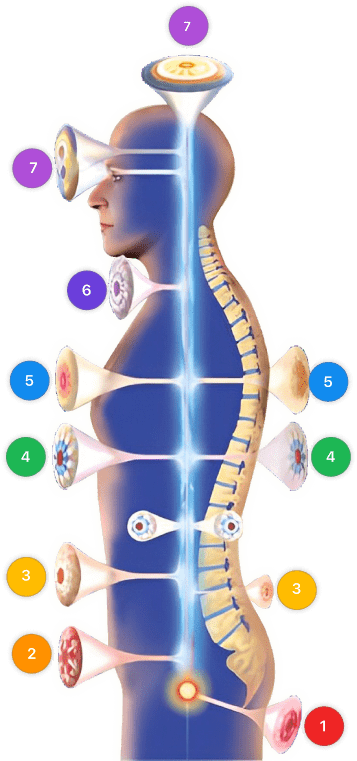 |
|
Use the Mirari Cold Plasma device to treat Fear blood/lymph disease other effectively.
WARNING: MIRARI COLD PLASMA IS DESIGNED FOR THE HUMAN BODY WITHOUT ANY ARTIFICIAL OR THIRD PARTY PRODUCTS. USE OF OTHER PRODUCTS IN COMBINATION WITH MIRARI COLD PLASMA MAY CAUSE UNPREDICTABLE EFFECTS, HARM OR INJURY. PLEASE CONSULT A MEDICAL PROFESSIONAL BEFORE COMBINING ANY OTHER PRODUCTS WITH USE OF MIRARI.
Step 1: Cleanse the Skin
- Start by cleaning the affected area of the skin with a gentle cleanser or mild soap and water. Gently pat the area dry with a clean towel.
Step 2: Prepare the Mirari Cold Plasma device
- Ensure that the Mirari Cold Plasma device is fully charged or has fresh batteries as per the manufacturer’s instructions. Make sure the device is clean and in good working condition.
- Switch on the Mirari device using the power button or by following the specific instructions provided with the device.
- Some Mirari devices may have adjustable settings for intensity or treatment duration. Follow the manufacturer’s instructions to select the appropriate settings based on your needs and the recommended guidelines.
Step 3: Apply the Device
- Place the Mirari device in direct contact with the affected area of the skin. Gently glide or hold the device over the skin surface, ensuring even coverage of the area experiencing.
- Slowly move the Mirari device in a circular motion or follow a specific pattern as indicated in the user manual. This helps ensure thorough treatment coverage.
Step 4: Monitor and Assess:
- Keep track of your progress and evaluate the effectiveness of the Mirari device in managing your Fear blood/lymph disease other. If you have any concerns or notice any adverse reactions, consult with your health care professional.
Note
This guide is for informational purposes only and should not replace the advice of a medical professional. Always consult with your healthcare provider or a qualified medical professional for personal advice, diagnosis, or treatment. Do not solely rely on the information presented here for decisions about your health. Use of this information is at your own risk. The authors of this guide, nor any associated entities or platforms, are not responsible for any potential adverse effects or outcomes based on the content.
Mirari Cold Plasma System Disclaimer
- Purpose: The Mirari Cold Plasma System is a Class 2 medical device designed for use by trained healthcare professionals. It has received clearance from the U.S. FDA and is registered for use in Thailand and Vietnam. It is not intended for use outside of these locations.
- Informational Use: The content and information provided with the device are for educational and informational purposes only. They are not a substitute for professional medical advice or care.
- Variable Outcomes: While the device is approved for specific uses, individual outcomes can differ. We do not assert or guarantee specific medical outcomes.
- Consultation: Prior to utilizing the device or making decisions based on its content, it is essential to consult with a Certified Mirari Tele-Therapist and your medical healthcare provider regarding specific protocols.
- Liability: By using this device, users are acknowledging and accepting all potential risks. Neither the manufacturer nor the distributor will be held accountable for any adverse reactions, injuries, or damages stemming from its use.
- Geographical Availability: This device has received approval for designated purposes by the Thai and Vietnam FDA. As of now, outside of Thailand and Vietnam, the Mirari Cold Plasma System is not available for purchase or use.
References
- Dr. Oracle AI. Patient with health anxiety and palpable lymph nodes. 2025. Available from: https://www.droracle.ai/articles/47186/patient-is-31-year-old-female-with-health-anxiety-and-palpable-left-elbow-lymph-nodes-
- Dr. Sarah Allen. A Guide on How To Overcome Health Anxiety With CBT. 2025. Available from: https://drsarahallen.com/treating-health-anxiety-cognitive-behavioral-therapy-cbt-a-comprehensive-guide/
- Medentic App. Person with feared complaint in whom no diagnosis is made. 2024. Available from: https://www.medentic.app/en/resources/icd-codes/z71-1
- ICD Codes AI. Z71.1: Billable ICD-10 Code for Person with feared health complaint. 2025. Available from: https://icdcodes.ai/icd10/Z71.1
- Cooper K, et al. Cognitive Behaviour Therapy for Health Anxiety: A Systematic Review and Meta-Analysis. Behav Cogn Psychother. 2017. Available from: https://pubmed.ncbi.nlm.nih.gov/28229805/
- Medentic App. ICD-10 Z71.1 Classification. 2024. Available from: https://www.medentic.app/en/resources/icd-codes/z71-1
- Dr. Sarah Allen. Health Anxiety Symptoms and Manifestations. 2025. Available from: https://drsarahallen.com/treating-health-anxiety-cognitive-behavioral-therapy-cbt-a-comprehensive-guide/
- Cooper K, et al. Health Anxiety Characteristics. Behav Cogn Psychother. 2017. Available from: https://pubmed.ncbi.nlm.nih.gov/28229805/
- Dr. Sarah Allen. Catastrophic Thinking in Health Anxiety. 2025. Available from: https://drsarahallen.com/treating-health-anxiety-cognitive-behavioral-therapy-cbt-a-comprehensive-guide/
- ICD Codes AI. Worried Well Classification. 2025. Available from: https://icdcodes.ai/icd10/Z71.1
- PMC. Stress-induced red nucleus attenuation and anxiety. 2023. Available from: https://pmc.ncbi.nlm.nih.gov/articles/PMC10616295/
- Dr. Sarah Allen. Health-related rumination. 2025. Available from: https://drsarahallen.com/treating-health-anxiety-cognitive-behavioral-therapy-cbt-a-comprehensive-guide/
- Wikipedia. Blood-injection-injury type phobia avoidance. 2024. Available from: https://en.wikipedia.org/wiki/Blood-injection-injury_type_phobia
- Dr. Oracle AI. Health-seeking behaviors in anxiety. 2025. Available from: https://www.droracle.ai/articles/47186/patient-is-31-year-old-female-with-health-anxiety-and-palpable-left-elbow-lymph-nodes-
- Cooper K, et al. Body checking behaviors in health anxiety. Behav Cogn Psychother. 2017. Available from: https://pubmed.ncbi.nlm.nih.gov/28229805/
- Dr. Sarah Allen. Information seeking in health anxiety. 2025. Available from: https://drsarahallen.com/treating-health-anxiety-cognitive-behavioral-therapy-cbt-a-comprehensive-guide/
- Cooper K, et al. Reassurance seeking in health anxiety. Behav Cogn Psychother. 2017. Available from: https://pubmed.ncbi.nlm.nih.gov/28229805/
- PMC. Blood Injury and Injection Phobia cardiovascular response. 2014. Available from: https://pmc.ncbi.nlm.nih.gov/articles/PMC4094700/
- Wikipedia. Blood-injection-injury phobia physical symptoms. 2024. Available from: https://en.wikipedia.org/wiki/Blood-injection-injury_type_phobia
- StatPearls. Specific Phobia physical symptoms. 2024. Available from: https://www.ncbi.nlm.nih.gov/books/NBK499923/
- Dr. Sarah Allen. Somatic symptoms in health anxiety. 2025. Available from: https://drsarahallen.com/treating-health-anxiety-cognitive-behavioral-therapy-cbt-a-comprehensive-guide/
- PMC. Sleep disturbances in anxiety disorders. 2023. Available from: https://pmc.ncbi.nlm.nih.gov/articles/PMC10616295/
- Cooper K, et al. Functional impairment in health anxiety. Behav Cogn Psychother. 2017. Available from: https://pubmed.ncbi.nlm.nih.gov/28229805/
- Wikipedia. Social impact of blood phobia. 2024. Available from: https://en.wikipedia.org/wiki/Blood-injection-injury_type_phobia
- Dr. Sarah Allen. Relationship impact of health anxiety. 2025. Available from: https://drsarahallen.com/treating-health-anxiety-cognitive-behavioral-therapy-cbt-a-comprehensive-guide/
- PMC. Blood Injury and Injection Phobia panic responses. 2014. Available from: https://pmc.ncbi.nlm.nih.gov/articles/PMC4094700/
- Cooper K, et al. Etiology of health anxiety. Behav Cogn Psychother. 2017. Available from: https://pubmed.ncbi.nlm.nih.gov/28229805/
- Dr. Sarah Allen. Anxiety sensitivity in health anxiety. 2025. Available from: https://drsarahallen.com/treating-health-anxiety-cognitive-behavioral-therapy-cbt-a-comprehensive-guide/
- Cooper K, et al. Uncertainty intolerance in health anxiety. Behav Cogn Psychother. 2017. Available from: https://pubmed.ncbi.nlm.nih.gov/28229805/
- Dr. Sarah Allen. Catastrophic misinterpretation. 2025. Available from: https://drsarahallen.com/treating-health-anxiety-cognitive-behavioral-therapy-cbt-a-comprehensive-guide/
- Cooper K, et al. Perfectionism and health anxiety. Behav Cogn Psychother. 2017. Available from: https://pubmed.ncbi.nlm.nih.gov/28229805/
- Wikipedia. Medical trauma and blood phobia. 2024. Available from: https://en.wikipedia.org/wiki/Blood-injection-injury_type_phobia
- PMC. Vicarious trauma and anxiety development. 2014. Available from: https://pmc.ncbi.nlm.nih.gov/articles/PMC4094700/
- Dr. Sarah Allen. Media influence on health anxiety. 2025. Available from: https://drsarahallen.com/treating-health-anxiety-cognitive-behavioral-therapy-cbt-a-comprehensive-guide/
- Cooper K, et al. False alarms in health anxiety development. Behav Cogn Psychother. 2017. Available from: https://pubmed.ncbi.nlm.nih.gov/28229805/
- PMC. Genetic factors in anxiety disorders. 2023. Available from: https://pmc.ncbi.nlm.nih.gov/articles/PMC10616295/
- PMC. Neurobiological factors in anxiety. 2023. Available from: https://pmc.ncbi.nlm.nih.gov/articles/PMC10616295/
- PMC. Stress response system in anxiety. 2023. Available from: https://pmc.ncbi.nlm.nih.gov/articles/PMC10616295/
- Dr. Sarah Allen. Attention bias in health anxiety. 2025. Available from: https://drsarahallen.com/treating-health-anxiety-cognitive-behavioral-therapy-cbt-a-comprehensive-guide/
- Cooper K, et al. Memory bias in health anxiety. Behav Cogn Psychother. 2017. Available from: https://pubmed.ncbi.nlm.nih.gov/28229805/
- Dr. Sarah Allen. Interpretation bias in health anxiety. 2025. Available from: https://drsarahallen.com/treating-health-anxiety-cognitive-behavioral-therapy-cbt-a-comprehensive-guide/
- PMC. Family modeling of health behaviors. 2014. Available from: https://pmc.ncbi.nlm.nih.gov/articles/PMC4094700/
- Cooper K, et al. Cultural factors in health anxiety. Behav Cogn Psychother. 2017. Available from: https://pubmed.ncbi.nlm.nih.gov/28229805/
- Dr. Sarah Allen. Healthcare experiences and health anxiety. 2025. Available from: https://drsarahallen.com/treating-health-anxiety-cognitive-behavioral-therapy-cbt-a-comprehensive-guide/
- Dr. Sarah Allen. Information overload and health anxiety. 2025. Available from: https://drsarahallen.com/treating-health-anxiety-cognitive-behavioral-therapy-cbt-a-comprehensive-guide/
- StatPearls. Comorbid anxiety disorders. 2024. Available from: https://www.ncbi.nlm.nih.gov/books/NBK499923/
- Cooper K, et al. Mood disorders and health anxiety. Behav Cogn Psychother. 2017. Available from: https://pubmed.ncbi.nlm.nih.gov/28229805/
- Dr. Sarah Allen. OCD and health anxiety comorbidity. 2025. Available from: https://drsarahallen.com/treating-health-anxiety-cognitive-behavioral-therapy-cbt-a-comprehensive-guide/
- Cooper K, et al. Assessment of health anxiety. Behav Cogn Psychother. 2017. Available from: https://pubmed.ncbi.nlm.nih.gov/28229805/
- StatPearls. Psychiatric history in specific phobia. 2024. Available from: https://www.ncbi.nlm.nih.gov/books/NBK499923/
- MSD Manuals. Physical examination in specific phobias. 2023. Available from: https://www.msdmanuals.com/professional/psychiatric-disorders/anxiety-and-stressor-related-disorders/specific-phobias
- StatPearls. DSM-5-TR criteria specific phobia. 2024. Available from: https://www.ncbi.nlm.nih.gov/books/NBK499923/
- Cooper K, et al. Health anxiety assessment instruments. Behav Cogn Psychother. 2017. Available from: https://pubmed.ncbi.nlm.nih.gov/28229805/
- ICD Codes AI. Illness anxiety disorder differential diagnosis. 2025. Available from: https://icdcodes.ai/icd10/Z71.1
- Wikipedia. Blood-injection-injury type phobia diagnosis. 2024. Available from: https://en.wikipedia.org/wiki/Blood-injection-injury_type_phobia
- PMC. The effect of SSRIs on fear learning: systematic review. 2023. Available from: https://pmc.ncbi.nlm.nih.gov/articles/PMC10593621/
- PsychCentral. SSRI treatment for specific phobias. 2024. Available from: https://psychcentral.com/anxiety/specific-phobia-treatment
- PMC. SSRIs effectiveness in anxiety disorders. 2023. Available from: https://pmc.ncbi.nlm.nih.gov/articles/PMC10593621/
- Healthcare Cost Information. Generic SSRI costs. 2024. Available from: Various pharmacy cost databases
- MSD Manuals. Benzodiazepine treatment specific phobias. 2023. Available from: https://www.msdmanuals.com/professional/psychiatric-disorders/anxiety-and-stressor-related-disorders/specific-phobias
- Healthcare Cost Information. Benzodiazepine costs. 2024. Available from: Various pharmacy cost databases
- MSD Manuals. Beta-blocker use in specific phobias. 2023. Available from: https://www.msdmanuals.com/professional/psychiatric-disorders/anxiety-and-stressor-related-disorders/specific-phobias
- Healthcare Cost Information. Beta-blocker costs. 2024. Available from: Various pharmacy cost databases
- Cooper K, et al. CBT effectiveness for health anxiety meta-analysis. Behav Cogn Psychother. 2017. Available from: https://pubmed.ncbi.nlm.nih.gov/28229805/
- Dr. Sarah Allen. CBT techniques for health anxiety. 2025. Available from: https://drsarahallen.com/treating-health-anxiety-cognitive-behavioral-therapy-cbt-a-comprehensive-guide/
- Healthcare Cost Information. Psychotherapy costs. 2024. Available from: Various mental health provider databases
- American Psychological Association. What Is Exposure Therapy? 2017. Available from: https://www.apa.org/ptsd-guideline/patients-and-families/exposure-therapy
- Division 12 APA. Exposure Therapies for Specific Phobias. 2022. Available from: https://div12.org/treatment/exposure-therapies-for-specific-phobias/
- Hoge EA, et al. Mindfulness-Based Stress Reduction vs Escitalopram for Anxiety Disorders. JAMA Psychiatry. 2023. Available from: https://jamanetwork.com/journals/jamapsychiatry/fullarticle/2798510
- MBSR Program Costs. Various MBSR providers. 2024. Available from: Various mindfulness program providers
- StatPearls. ACT for anxiety disorders. 2024. Available from: https://www.ncbi.nlm.nih.gov/books/NBK499923/
- Cooper K, et al. Group therapy for health anxiety. Behav Cogn Psychother. 2017. Available from: https://pubmed.ncbi.nlm.nih.gov/28229805/
- Group Therapy Costs. Various mental health providers. 2024. Available from: Various mental health provider databases
- MSD Manuals. Relaxation techniques for specific phobias. 2023. Available from: https://www.msdmanuals.com/professional/psychiatric-disorders/anxiety-and-stressor-related-disorders/specific-phobias
- PMC. Mindfulness-Based Interventions for Anxiety and Depression. 2017. Available from: https://pmc.ncbi.nlm.nih.gov/articles/PMC5679245/
- Dr. Sarah Allen. Stress management in health anxiety. 2025. Available from: https://drsarahallen.com/treating-health-anxiety-cognitive-behavioral-therapy-cbt-a-comprehensive-guide/
- American College of Sports Medicine. Exercise for Mental Health. 2024. Available from: https://www.acsm.org/
- Cooper K, et al. Treatment monitoring health anxiety. Behav Cogn Psychother. 2017. Available from: https://pubmed.ncbi.nlm.nih.gov/28229805/
- StatPearls. Follow-up care specific phobia. 2024. Available from: https://www.ncbi.nlm.nih.gov/books/NBK499923/
- Dr. Sarah Allen. Patient education health anxiety. 2025. Available from: https://drsarahallen.com/treating-health-anxiety-cognitive-behavioral-therapy-cbt-a-comprehensive-guide/
- American Psychological Association. Breathing exercises for anxiety. 2017. Available from: https://www.apa.org/ptsd-guideline/patients-and-families/exposure-therapy
- National Cancer Institute SEER Program. Cancer Stat Facts: Leukemia. 2025. Available from: https://seer.cancer.gov/statfacts/html/leuks.html
Related articles
Made in USA
